Meeting of the
Corporate and Strategic Committee
Date: 16 March 2022
Time: 9.00am
|
Venue:
|
Council
Chamber
Hawke's
Bay Regional Council
159
Dalton Street, Napier
|
Agenda
Item Title Page
1. Welcome/Karakia/Notices/Apologies
2. Conflict
of Interest Declarations
3. Confirmation of Minutes of
the Corporate and Strategic Committee held on 17 November 2021
4. Follow-ups
from Previous Corporate and Strategic Committee Meetings 3
5. Call
for Minor Items Not on the Agenda 7
Decision
Items
6. Clifton
to Tangoio Coastal Hazards Strategy - Memorandum of Transition 9
7. Order
of Candidates Names on Voting Documents 57
8. Proposal
to Participate in Regional Sector Council-Controlled Organisation 61
9. Updated
HBRC Appointment and Remuneration of Directors Policy 81
10. HBRIC
and Foodeast Draft Statements of Intent 89
Information
or Performance Monitoring
11. HBRIC
Quarterly Update 117
12. Report
from the Finance Audit and Risk Sub-committee Meeting 127
13. Financial
Report for the Period 1 July - 31 Dec 2021 133
14. Organisational
Performance Report for the Period 1 October - 31 December 2021 141
15. Corporate
Plan Implementation 169
16. Discussion
of Minor Items not on the Agenda 179
Decision
Items (Public Excluded)
17. Report
from the Public Excluded Finance, Audit and Risk Sub-committee Meeting 181
18. Possible
Sale of Wellington Leasehold Property 182
HAWKE’S BAY REGIONAL
COUNCIL
Corporate
and Strategic Committee
16 March
2022
Subject: Follow-ups from Previous
Corporate and Strategic Committee Meetings
Reason for Report
1. On the attached list are
items raised at previous Corporate and Strategic Committee meetings that staff
have followed up on. All items indicate who is responsible for follow up, and a
brief status comment. Once the items have been reported to the committee they
will be removed from the list.
Decision Making Process
2. Staff have assessed the
requirements of the Local Government Act 2002 in relation to this item and have
concluded that, as this report is for information only, the decision-making
provisions do not apply.
Recommendation
That the Corporate and
Strategic Committee receives and notes the attached Follow-up Items from
Previous Meetings.
Authored by:
|
Leeanne Hooper
Team Leader Governance
|
|
Approved by:
|
Jessica Ellerm
Group Manager Corporate Services
|
|
Attachment/s
|
1⇩
|
Follow-ups from Previous Meetings
|
|
|
|
Follow-ups from Previous Meetings
|
Attachment
1
|

HAWKE’S
BAY REGIONAL COUNCIL
Corporate
and Strategic Committee
16 March
2022
Subject: Call for Minor Items Not on
the Agenda
Reason
for Report
1. This item provides the
means for committee members to raise minor matters relating to the general business of
the meeting
they wish to bring to the attention of the committee.
2. Hawke’s Bay Regional
Council standing order 9.13
states:
2.1. “A meeting may discuss an
item that is not on the agenda only if it is a minor matter relating to the
general business of the meeting and the Chairperson explains at the beginning
of the public part of the meeting that the item will be discussed. However, the
meeting may not make a resolution, decision or recommendation about the item,
except to refer it to a subsequent meeting for further discussion.”
Recommendations
3. That the Corporate and
Strategic Committee accepts the following Minor Items Not on the Agenda for discussion
as Item 16.
|
Leeanne
Hooper
GOVERNANCE
TEAM LEADER
|
James
Palmer
CHIEF
EXECUTIVE
|
HAWKE’S BAY REGIONAL
COUNCIL
Corporate
and Strategic Committee
16 March
2022
Subject: Clifton to Tangoio Coastal
Hazards Strategy - Memorandum of Transition
Reason for Report
1. This item presents a
proposed Memorandum of Transition (MoT) to confirm Council roles and
responsibilities for the implementation of the Clifton to Tangoio Coastal
Hazards Strategy (Strategy).
Officers’
Recommendations
2. Staff recommend that the
Committee endorses the Memorandum of Transition as proposed, for Council
adoption and execution by the Chief Executive.
Executive
Summary
3. A proposed MoT has been
developed to give effect to the outcome of the Funding Review, led by Raynor
Asher, QC.
4. The MoT has been endorsed
by Napier City Council (NCC) and Hastings District Council (HDC).
5. Hawke’s Bay Regional
Council (HBRC) has received further advice to assist in its consideration of
the MoT, and a decision is now being sought.
6. If HBRC endorses the MoT, a
public consultation process will follow in the form of a proposal by HBRC under
s.16 of the Local Government Act.
Background
7. All Partner Councils have
agreed in principle to the outcomes of the funding review led by Raynor Asher,
QC.
8. As the first phase of
implementing the funding review outcomes, the Technical Advisory Group (TAG)
has prepared a draft MoT.
9. The purpose of the MoT is
to provide a mechanism for HBRC, HDC and NCC to confirm the agreed arrangements
for implementing the Strategy and the associated transfer of assets recommended
by the funding review.
10. These implementation
arrangements, if confirmed, would be actioned through a proposal by HBRC to
amend its Long Term Plan by proposing to undertake a significant new activity
under s.16 of the Local Government Act.
11. The MOT will also provide
the means for HBRC to complete the s.16 process without objection from territorial
authorities in the region (including Wairoa District Council and Central
Hawke’s Bay District Council).
12. Associated with the MoT, an
advisory committee was recommended by Mr Asher to support HBRC’s
functions as the lead agency for implementing the Strategy. This advisory
committee will in effect replace the Clifton to Tangoio Coastal Hazards
Strategy Joint Committee and provide for an ongoing forum for collaboration
between tāngata whenua and the councils.
13. The MoT is provided as Attachment
1 to this paper.
14. A draft terms of reference
for the proposed advisory committee is included as Schedule One to the MoT.
15. In December 2021, the MoT
was endorsed by HDC and NCC. Both Councils have delegated authority to their
Chief Executives to execute the MOT on their behalf.
16. HBRC considered the MoT in
workshop in December 2021, however, it deferred a decision to endorse the MoT
pending receipt of further advice and analysis.
17. This advice and analysis
was presented in workshop and in the Council meeting on 23 February 2022. As a
result of advice received, Councillors sought minor amendments to the MoT and
instructed staff to discuss these proposed changes with HDC and NCC.
18. The amendments sought by HBRC
are shown as tracked changes in Attachment 1. Amendments are proposed to
Clause 7.2 and a new proposed clause 7.10 has been inserted. For completeness,
TAG has also proposed that the Whakarire Avenue revetment is removed from the
MoT at this stage, as the works are consented but not yet constructed. This
change is also shown as tracked.
19. Staff have consulted with
HDC and NCC on the changes proposed by HBRC. Both councils have confirmed their
agreement to the proposed changes through their Chief Executives.
Options
Assessment
20. The MoT is a key next step
in confirming the outcome of the funding review led by Raynor Asher.
21. HDC and NCC have confirmed
their agreement to the MoT, and have subsequently accepted changes proposed by
HBRC from their meeting on 23 February 2022.
22. HBRC is now asked to
consider and endorse the final MoT. Staff consider that this presents HBRC with
two options, as follows.
Option
One (Recommended Option)
23. Council endorses the MoT,
as attached, and instructs the Chief Executive to execute this on behalf of
Hawke’s Bay Regional Council following satisfaction of consultation
requirements under Clause 7 of the Hawke’s Bay Region’s Triennial
Agreement for the Triennium October 2019 – 2022.
Advantages
23.1. Council has previously
agreed in principle to the outcome of the funding review, and has considered
the proposal, as outlined in the MoT, in some detail along with further advice
and analysis.
23.2. Mr Asher has set out, in
his advice, detailed reasons for his recommendation that that the Regional
Council is the organisation best placed to take charge of all aspects of
adapting to coastal hazards in the Clifton to Tangoio Coastal area.
23.3. The process of confirming
roles and responsibilities for strategy implementation between councils has
raised important and significant questions, and has taken some time to work
through. More significant work lies ahead, including determining how to fairly
apportion costs between ratepayers for coastal hazards mitigation. Endorsing
the MoT will clear the way for this next important phase of work to commence.
Disadvantages
23.4. The MoT proposes that HBRC
take on a significant new activity. This will result in increased costs for the
organisation, and increased resourcing and capability requirements.
Option
Two – Status Quo
24. Council does not endorse
Memorandum of Transition and instructs officers to revisit Funding Review
outcomes.
Advantages
24.1. HBRC would not be exposed
to the cost and resource implications associated with leading strategy
implementation.
Disadvantages
24.2. This option is not
supported by officers. As noted above, Mr Asher has outlined with sound
reasoning why HBRC is best placed to lead strategy implementation. The draft
MOT has had significant input from the strategy’s Technical Advisory
Group, has had legal input from Simpson Grierson, and has been endorsed by the
Joint Committee which includes representatives from HBRC, HDC and NCC. The MoT
has also been formally endorsed by HDC and NCC.
24.3. HBRC has been presented
with, and had the opportunity to further consider, advice relative to the
potential liabilities, costs and resourcing implications associated with its
endorsement of the MoT.
24.4. If the MoT is not endorsed
by HBRC, the Strategy itself has no agreed mechanism for implementation. Other
options, which were assessed by Mr Asher but were found to be far less
effective and desirable, would need to be considered.
Strategic Fit
25. Climate Change is at the
heart of everything we do.
The coastal strategy aims to provide coastal communities, businesses and
critical infrastructure from Clifton to Tangoio are resilient to the effects of
coastal hazards. Climate change and the corresponding sea level rise is the
primary hazard being mitigated through this strategy.
26. The strategy would sit
under the sustainable and climate-resilient services and infrastructure HBRC
Strategic Objective.
Why
the Strategy is a Priority
27. High performing regional
infrastructure enables the region’s natural and human resources to
deliver goods and services that underpin the prosperity and wellbeing of the
Hawke’s Bay community.
Climate
Change Impacts
28. The climate assumptions that
underpin our infrastructure investments and decisions are changing
rapidly. We must ensure our assets and services are future proofed for
climate change impacts, which supports the leading edge adaptive pathways
approach of the strategy.
Strategic
Outcome
29. The region has resilient
physical, community and business infrastructure to unlock potential growth and
prosperity from our natural resource base, which aligns with the coastal
strategy’s vision.
Significance
and Engagement Policy Assessment
30. If endorsed by HBRC, the
MoT will be actioned through a proposal by HBRC under s.16 of the Local
Government Act. This requires full community consultation. HBRC would make a
final decision following the outcome of that consultation process.
31. Further to the s.16
process, more detail on the delivery model, programme and funding will be
developed for consultation through the 2024-2034 Long Term Plan.
Considerations
of Tāngata Whenua
32. The MoT has been endorsed
by the Strategy’s Joint Committee, which includes representation from the
Maungaharuru-Tangitū Trust, Mana Ahuriri Trust and Heretaunga Tamatea
Settlement Trust (although the Joint Committee is waiting to confirm new
representatives for Mana Ahuriri Trust and Heretaunga Tamatea Settlement
Trust).
33. A Mana Whenua Engagement
Strategy has also been activated as part of work under the Strategy and this
work is ongoing.
34. As noted, if HBRC endorse
the MoT, a s.16 consultation process will follow, providing further opportunity
for input from tāngata whenua. The Mana Whenua Engagement Strategy has
been designed to support and facilitate this input.
Financial
and Resource Implications
35. Staff presented financial
analysis in the report to Council on 23 February 2022, HBRC Internal Review
– Coastal Hazards Strategy Implementation.
36. This analysis included an
assessment of indicative potential costs and rating impacts for the 2021-2031
LTP 10 year period should HBRC agree to implement the strategy.
37. Rather than repeat this
analysis here, this report is provided as Attachment 2.
38. Full financials and rating
methodology will be developed for consultation as part of the proposed
2024-2034 LTP (refer Table 1).
Next Steps
39. Staff propose to take the
MoT and the recommendations of this Committee to full Council on 30 March
2022.
40. Should HBRC agree to
endorse the MoT, the following sequential steps will occur:
40.1. Agreement will be sought
from Wairoa District Council and Central Hawke’s Bay District Council
that they do not object to the MoT, and the s.16 proposal that will follow from
it.
40.2. Hastings District Council
will consult with ratepayers who may be affected by the proposed transfer of
the Waimarama seawall.
40.3. The Chief Executives of
HBRC, NCC and HDC will be invited to execute the MoT, in accordance with the
resolutions passed by each Council.
40.4. The Minister of Local
Government will be informed of the proposal and the reasons for it, in
accordance with the requirements of s.16(2) of the Local Government Act
40.5. HBRC will notify the
proposal under s.16 of the Local Government Act (this is targeted to occur in
May 2022).
41. Further decision-making
steps are outlined below in Table 1.
Table 1: Strategy Consultation and Implementation Timeframes
|
Timing
|
Critical Tasks + Decision Gateways
|
|
To
end of Feb 2022
|
- Pre-consultation
Mana whenua engagement, community workshops, community engagement
|
|
Decision Gateway 1: Memorandum of Transition
|
|
Oct
2021 – May 2022
|
- Memorandum of Transition
development and approval
- LTP Amendment preparation
Councillor workshops / consultation material preparation
|
|
Timing
|
Critical Tasks + Decision Gateways
|
|
Decision Gateway 2: Notification of LTP Amendment
|
|
May-June
2022
|
- Consultation
LTP Amendment notified as s.16 proposal (significant new activity for
HBRC)
|
|
July-August
2022
|
- Hearings / deliberations
/ decisions
|
|
Decision Gateway 3: Adoption of LTP Amendment & Strategy
|
|
August
2022
|
- Consenting process
commences for physical works (est. 2 years)
|
|
October
2022
|
- Local Body Elections
|
|
March
2024
|
- Triennial LTP review to
include funding for physical works
|
|
Decision Gateway 4: Adoption of LTP including funding provisions
|
|
July
2024
|
- Strategy implementation
rating commences
|
|
September
2024 (est.)
|
- Construction phase
commences
|
Decision Making Process
42. Council and its committees
are required to make every decision in accordance with the requirements of the
Local Government Act 2002 (the Act). Staff have assessed the requirements in
relation to this item and have concluded:
42.1. The decision does not
significantly alter the service provision or affect a strategic asset, nor is
it inconsistent with an existing policy or plan.
42.2. The use of the special
consultative procedure is proposed to occur in accordance with s.16 of the
Local Government Act, in order to give effect to the proposal as set out in the
MoT.
42.3. The decision to endorse the
MoT is not itself significant under the criteria contained in Council’s
adopted Significance and Engagement Policy.
42.4. The persons affected by
this decision are the ratepayers of the Napier and Hastings Districts, and they
will be provided with the opportunity to participate as part of the s.16
consultation process.
43. Given the nature and
significance of the issue to be considered and decided, and also the persons
likely to be affected by, or have an interest in, the decisions made, Council
can exercise its discretion and make a decision to endorse the MoT without
consulting directly with the community or others having an interest in the
decision. It is noted that this decision will lead to the development of a
proposal under s.16 of the Local Government Act that will be the subject of a
public consultation process.
Recommendations
1. That the Corporate and
Strategic Committee receives and notes the Clifton to Tangoio Coastal
Hazards Strategy - Memorandum of Transition staff report.
2. The Corporate and Strategic
Committee recommends that Hawke’s Bay Regional Council:
2.1. Agrees that the decisions
to be made are not significant under the criteria contained in Council’s
adopted Significance and Engagement Policy, and that Council can exercise its
discretion and make decisions on this issue without conferring directly with
the community or persons likely to have an interest in the decision.
2.2. Endorses the Memorandum of
Transition as proposed.
2.3. Instructs the Chief
Executive to execute the Memorandum of Transition on behalf of the
Hawke’s Bay Regional Council following satisfaction of consultation
requirements under Clause 7 of the Hawke’s Bay Region’s Triennial
Agreement for the Triennium October 2019 – 2022.
2.4. Delegates to the Chief
Executive authority to approve changes to the Memorandum of Transition should
they be required by the Hastings District Council and Napier City Council in
consultation with the Hawke’s Bay Regional Council members of the Clifton
to Tangoio Coastal Hazards Strategy Joint Committee.
Authored by:
|
Simon Bendall
Coastal Hazards Strategy Project Manager
|
|
Approved by:
|
Chris Dolley
Group Manager Asset Management
|
|
Attachment/s
|
1⇩
|
Memorandum of Transition
|
|
|
|
2⇩
|
Report: HBRC Internal Review –
Coastal Hazards Strategy Implementation, 23 February 2022
|
|
|
|
Memorandum of Transition
|
Attachment
1
|


















|
Report: HBRC Internal Review – Coastal Hazards Strategy
Implementation, 23 February 2022
|
Attachment
2
|















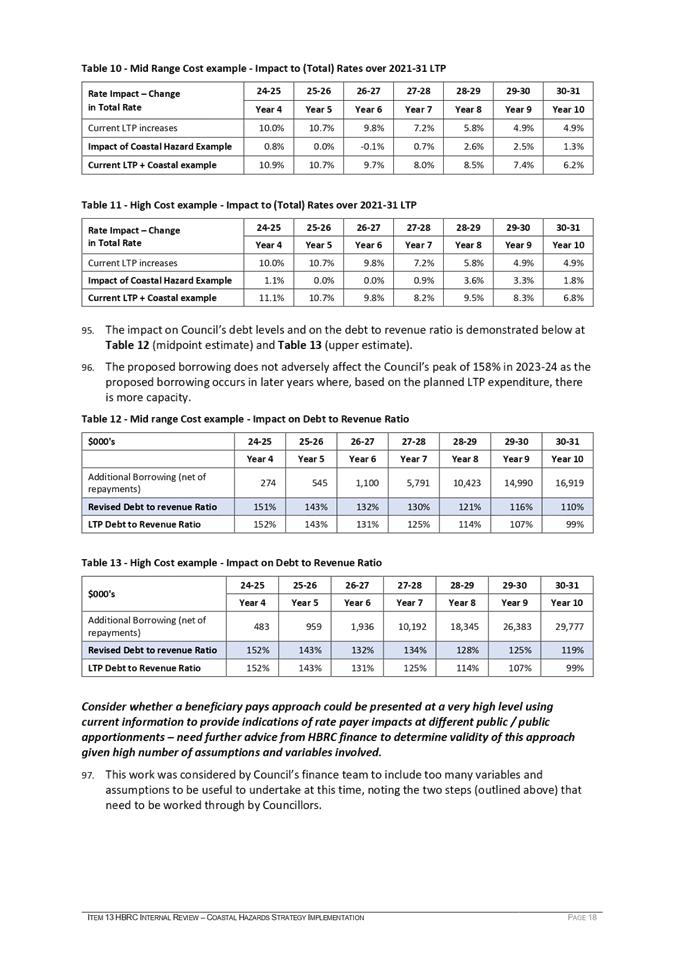



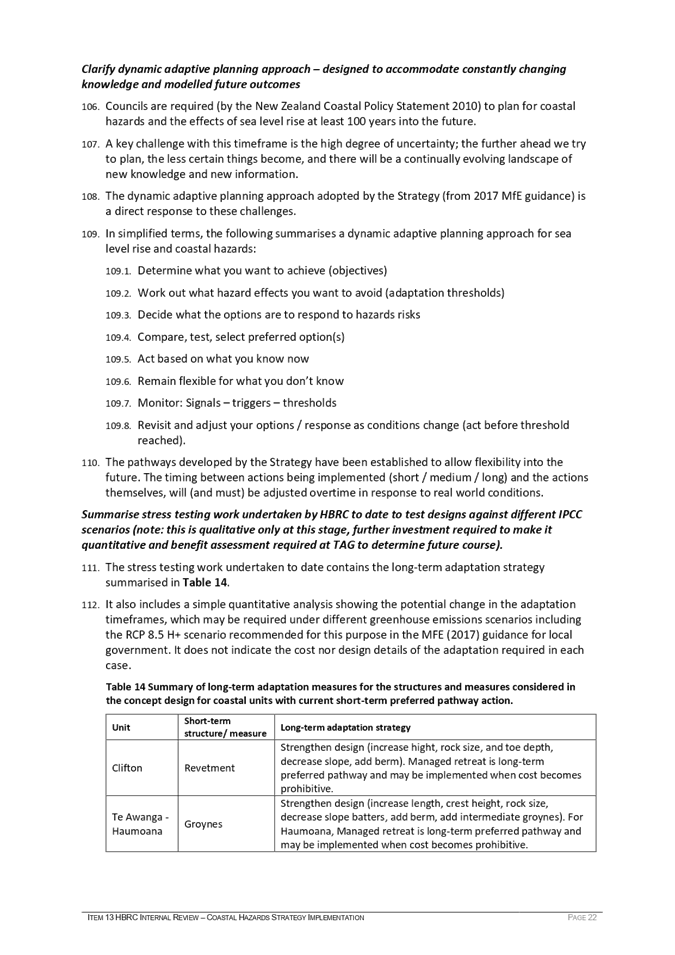
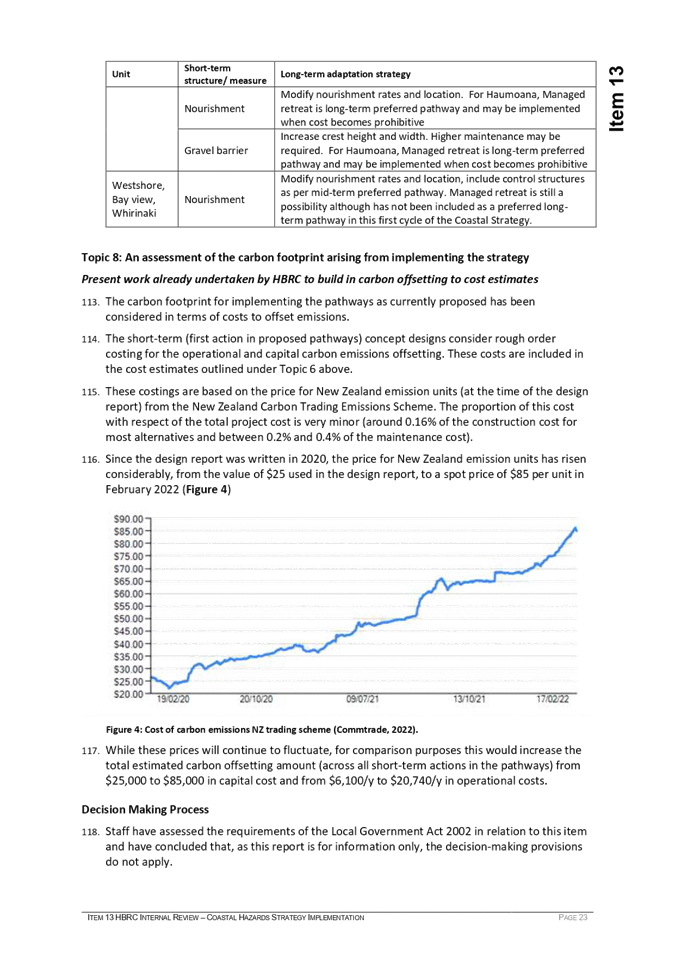

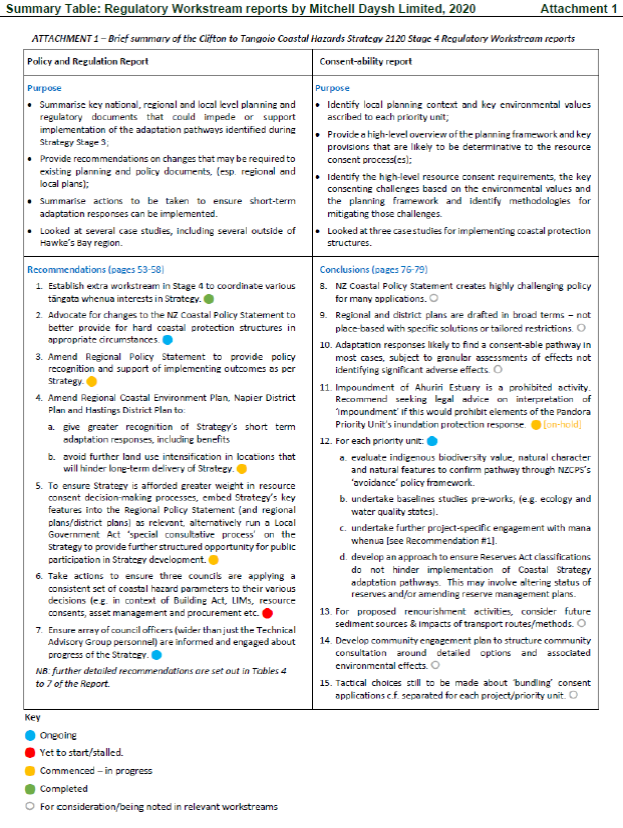

HAWKE’S
BAY REGIONAL COUNCIL
Corporate
and Strategic Committee
16 March
2022
Subject: Order of Candidates Names on
Voting Documents
Reason for Report
1. This item seeks a decision
on the order of candidates’ names on voting documents for the next (2022)
local body elections.
Officers’
Recommendations
2. Staff recommend that the
Council chooses to list candidates names in random order on the 2022 local body
election voting documents. Staff consider that is the fairest order as it
removes name order bias and is increasingly adopted by councils in local body
elections.
Background
3. Regulation 31 of the Local
Electoral Regulations 2001 provides the opportunity for Council to choose the
order of candidate names appearing on the voting documents from three options -
alphabetical, pseudo-random (names drawn out of a hat with all voting documents
printed in this order) or random order (names randomly drawn by computer with
each voting document different).
4. Council has used
alphabetical order for all previous elections.
5. The decision on the order
of candidate names must be made in early 2022 to enable printing of voting
documents. If no decision is made, the order of names defaults to alphabetical.
Options
Alphabetical Order
6. Alphabetical order is
simply listing candidate names alphabetically and is the order traditionally
used in local authority and parliamentary elections.
Pseudo-random
Order
7. Under this arrangement, the
candidates’ names for each issue (election) are placed in a hat (or
similar receptacle), mixed together, and then drawn out of the receptacle, with
candidates’ names being placed for all voting documents for that
issue in the order they are drawn.
8. The regulations provide
that if a council has determined that pseudo-random order is to be used, the
Electoral Officer must state, in the public notice required to be given, the
date, time and place in which the order of the candidates’ names will be
arranged. Any person is then entitled to attend while the draw is in progress.
Random
Order
9. Under this arrangement, the
names of the candidates for each issue (election) are shown in a different
order on each and every voting document, utilising software which enables the
names of candidates to be printed in a different order on each paper.
Advantages and disadvantages of the
options
10. The advantage of
alphabetical order is that it is familiar and easier to understand for voters.
Where there is a large number of candidates competing for a position, it is
easier for a voter to find a candidate they wish to vote for if the names are
listed alphabetically.
11. It is also easier for a
voter if the order of names on the voting document follows the order of names
in the directory of candidate profile statements accompanying the voting
document.
12. Random order (both random
and pseudo-random) removes the potential for name order bias, but the
pseudo-random order of names simply substitutes a different order for an
alphabetical order. Any first-name bias will transfer to the name at the top of
the pseudo-random list. Therefore the only effective alternative to
alphabetical order is random order.
13. A disadvantage for both the
random options is voter confusion as it is not possible for the supporting
documents such as the candidate profile statement booklets to follow the order
of a random voting paper. Making voting more difficult carries the risk of
deterring the voter from taking part.
Research
on name order bias
14. Research on voting patterns
has indicated that candidates with a surname starting at the top end of the
alphabet may have a slight advantage over others with a lower alphabetical
ranking.
14.1. Delbert
A. Taebel showed that not only did candidates listed first enjoy a favourable advantage,
but that this advantage was greater in contests further down the ballot. This
advantage did not, however, hold when voters had high recognition of candidate
names. This suggests that presidential elections, where there is generally much
higher name recognition than in primary and off-year elections, are less likely
to be influenced by name-order effects. The flip side of this was that in this
study, low name recognition meant that voters were less likely to make any
choice at all for those unknown candidates. The Effect of Ballot Position on
Electoral Success Delbert A. Taebel American
Journal of Political Science Vol. 19, No. 3 (Aug., 1975), pp.
519-526 (8 pages) Published by: Midwest Political Science Association.
14.2. More
recently, Jonathan G. Koppell and Jennifer A. Steen studied an actual election in which the names were rotated on the ballots by
precincts. In 71 of 79 New York City Democratic Primary
contests, candidates received a greater proportion of votes when they were
listed first compared to any other position they were listed in. For 7 of the
71 contests where this was the case, the advantage of first position exceeded
the winner’s margin, “suggesting that the ballot position would
have determined the election’s outcomes if one candidate had held the top
spot in all precincts.” The Effects of Ballot Position on Election Outcomes The Journal of
Politics Vol. 66, No. 1 (Feb., 2004), pp. 267-281 (15 pages) Published by: The University of Chicago Press on behalf of the Southern Political Science Association.
14.3. A study by Nuri Kim, Jon
Krosnick and Daniel Casasanto found, in an experiment embedded in a
large (USA) national Internet survey, participants read about the issue
positions of two hypothetical candidates and voted for one of them in a
simulated election in which candidate name order was varied. The expected
effect of position appeared and was strongest (1) when participants had less
information about the candidates on which to base their choices, (2) when
participants felt more ambivalent about their choices, (3) among participants
with more limited cognitive skills, and (4) among participants who devoted less
effort to the candidate evaluation process. The name-order effect was greater
among left-handed people when the candidate names were arrayed horizontally,
but there was no difference between left- and right-handed people when the
names were arrayed vertically. These results reinforce some broad theoretical
accounts of the cognitive process that yield name-order effects in elections. Political
Psychology Vol. 36, No. 5 (OCTOBER 2015), pp. 525-542, published by International Society of Political
Psychology.
National
and local context
14.4. A Government response to
the Report of the Justice and Electoral Committee on its Inquiry into the
2013 local authority elections stopped short of recommending that the order
on all ballot papers in local authority elections be completely
randomised, but did encourage councils to consider adopting the randomisation
of names under the existing provision.
14.5. Random order for voting
papers has been increasingly adopted by local councils. For the 2019 elections
all of the region’s councils except Wairoa District and Hawke’s Bay
Regional councils resolved to use random order.
Financial
and Resource Implications
15. Technological developments
for the printing of voting papers is such that there is no difference in either
cost or quality for the printing of alphabetical or randomised voting papers.
Costs are provided for in existing budgets.
Decision Making Process
16. Council and its committees
are required to make every decision in accordance with the requirements of the
Local Government Act 2002 (the Act). Staff have assessed the requirements in
relation to this item and have concluded:
16.1. The decision is provided
for under Regulation
31 of the Local Electoral Regulations 2001
16.2. The persons affected by
this decision are candidates and voters in the local body elections.
16.3. Given the nature of the
issue to be considered and decided Council can exercise its discretion and make
the relevant decisions without consulting directly with the community or others having an interest
in the decision.
Recommendations
1. That the Corporate and
Strategic Committee receives and considers the Order of Candidates Names on
Voting Documents staff report.
2. The Corporate and Strategic
Committee recommends that Hawke’s Bay Regional Council:
2.1. Agrees that the decisions
to be made are not significant under the criteria contained in Council’s
adopted Significance and Engagement Policy, and that Council can exercise its
discretion and make decisions on this issue without conferring directly with
the community or persons likely to have an interest in the decision.
2.2. Resolves that the names of
candidates at the 2022 Hawke’s Bay Regional Council elections and any
intervening by-elections be arranged in random order.
Authored
by:
|
Leeanne Hooper
Team Leader Governance
|
|
Approved by:
|
Desiree Cull
Strategy & Governance Manager
|
|
Attachment/s
There are no attachments for this
report.
HAWKE’S
BAY REGIONAL COUNCIL
Corporate
and Strategic Committee
16 March
2022
Subject: Proposal to Participate in
Regional Sector Council-Controlled Organisation
Reason for Report
1. This report asks the
Committee to recommend participation in a Regional Sector Shared Services Council
Controlled Organisation, subject to consultation.
2. The Council is required
under section 56 of the Local Government Act 2002 (LGA) to undertake
consultation before establishing or becoming a shareholder in a CCO. This
paper asks the Committee to recommend a streamlined consultation approach as
detailed below.
3. Mark Donnelly the General
Manager of RSHL (Regional Software Holdings Limited) will be in attendance via
Zoom to answer questions.
Background
4. The 16 Regional Councils
and Unitary Authorities in Aotearoa New Zealand work together on areas of
shared interest, but now wish to take this arrangement a step further through
the creation of a shared services company. This is in response to:
4.1. Increased demands from
Central Government to deliver a broad range of reform packages.
4.2. Capacity and capability
challenges and competition between councils to attract and retain talent.
4.3. Expectations from our
communities for councils to do more with less.
5. At the Regional Chief
Executives Group meeting on 3 August 2021, the business case for the creation
of a Regional Sector Shared Services Organisation was tabled for approval. The
creation of a Regional Sector Shared Services Organisation was considered as a
step forward for the sector, and an important foundational building block for
future collaboration and delivery of shared services and initiatives.
6. The business case
recommended the creation of an organisation that all regional councils and
unitary authorities will invest in, fairly sharing the benefits, costs, and
risks of the investment. This change will enable improved outcomes from
investment into national programmes of work. It will also improve access to
specialist and expensive resource, reducing costs and sharing risk.
Structure
7. The company will be created
by restructuring RSHL (Regional Software Holdings Limited), a pre-existing
Council Controlled Organisation (CCO) created by six regional councils for this
purpose. The six existing shareholders do not need to consult.
8. A council-controlled
organisation can be a company, partnership, trust, arrangement for the sharing
of profits, union of interest, co-operation, joint venture or other similar
arrangement in which one or more local authorities, directly or indirectly,
controls the organisation.
9. It is intended that the
Regional Sector Shared Services organisation will be a company, with up to 16
shareholders, being the 16 regional councils and unitary authorities in New
Zealand.
10. The table below shows each
Council’s intention as at 28 January 2022.
|
Council
|
Intend
to join
|
|
Environment
Southland
|
Yes
(existing RSHL shareholder)
|
|
Horizons
Regional Council
|
Yes
(existing RSHL shareholder)
|
|
Northland
Regional Council
|
Yes
(existing RSHL shareholder)
|
|
Taranaki
Regional Council
|
Yes
(existing RSHL shareholder)
|
|
West
Coast Regional Council
|
Yes
(existing RSHL shareholder)
|
|
Waikato
Regional Council
|
Yes
(existing RSHL shareholder)
|
|
Otago
Regional Council
|
Yes
|
|
Bay
of Plenty Regional Council
|
Yes
|
|
Gisborne
District Council
|
Yes
|
|
Greater
Wellington Regional Council
|
Maybe
|
|
Environment
Canterbury
|
Maybe
|
|
Tasman
District Council
|
Maybe
in 2023
|
|
Marlborough
District Council
|
Talking
to Council
|
|
Nelson
City Council
|
Talking
to Council
|
|
Auckland
Council
|
No
|
11. Depending on the final
adopted structure of the council-controlled organisation, the Council may hold
shares or some other form of ownership. The Council will contribute to the
operating costs of the council-controlled organisation, these contributions
will replace existing contributions to national programmes, and will be at a
similar level.
12. The Council will maintain
its ownership of the CCO as long as it continues to operate and the Council
continues to utilise the services provided by the council-controlled
organisation.
Operation
13. Once established, the CCO
will prepare a statement of intent. This statement of intent will form the
basis of key performance targets and other measures by which the performance of
the company may be judged.
Nature
and scope of activities
14. RSHL will provide a
framework for collaboration between the shareholders and across the regional
sector. It will support the procurement or development of shared solutions in a
manner that provides greater consistency in how council operate their core
processes. RSHL will provide a more cost-effective alternative than individual
councils can achieve on their own.
15. The company will operate by
facilitating collaborative initiatives between councils and through managed
contractual arrangements.
16. The initial scope of
activities for the company is limited to pre-existing shared services
programmes.
17. A business case will be
developed for any additional service that is not part of the original company.
The business case will be approved by the shareholders prior to any new service
proceeding. The investigation of any new services will be fully funded by
councils that wish to promote that service.
Council policies and objectives
relating to CCOs
18. Council does not have any
significant policies or objectives about ownership and control of a company as
a vehicle for shared services. Council has a policy on the appointment and
remuneration of directors, which is currently under review and available on
request. The constitution of any company structure set up for this project will
have the principles according to which the company will be operated and
governed. This includes shareholders’ rights and the appointment of
directors. The annual statement of intent identifies the activities and
intentions of the company for the year and the objectives to which those
activities will contribute.
Performance targets
19. Performance targets relate
to the level of services that the company will achieve to deliver on its stated
outcomes. It is envisaged that these targets will change as new services are
developed.
19.1. Customers will be surveyed
annually to ensure that there is at least 75 per cent satisfaction with the services
provided.
19.2. Expenditure shall not
exceed that budgeted by more than 5 per cent unless prior approval is obtained
from the shareholders.
19.3. The organisation will
demonstrate material benefit to the regional sector and shareholders.
Benefits of joining
20. The CCO is intended to be
the delivery mechanism for the projects that are identified by the regional
sector special interest groups (SIGs) and prioritised by the regional sector
CEOs through the ReCoCo (Regional Council Collaboration) programme. RSHL is
well placed to deliver this:
20.1. RSHL is already responsible
for the management and delivery of sector programmes with an annual budget of
$2.5-$3m.
20.2. RSHL also has a good track
record of delivering technology projects, such as the original design and build
of the IRIS regulatory software.
21. Involvement in the CCO
won’t require any additional funding initially, the operating costs will
be covered by existing ReCoCo subscription fees that are paid by all regional
councils. Additional costs are incurred when each Council decides to
participate in and contribute funding towards a work programme.
22. Council has a long standing
relationship with RSHL, which has delivered benefits through access to:
22.1. cost-effective solutions
that are specifically designed for the unique functions of a regional council
22.2. a sector-wide body of
knowledge of Council business processes in the IT, regulatory, biodiversity and
land management functions of a regional council.
23. The CCO proposal is an appropriate
next step in the evolution of our long-standing relationship with RSHL.
Becoming a shareholder moves us from being a customer, into a more influential
role as a stakeholder. This role will enable us to actively contribute to the
design of processes and solutions that drive the sector alignment and
efficiencies that the shared services work programme is intended to deliver.
IRIS Next Generation Work Programme
24. The first CCO work
programme of significance to Council is the IRIS Next Generation programme.
This programme is intended to deliver sector alignment through consistent good
practice business processes that are embedded in modern extensible software.
The scope of the programme covers the regulatory, land management and
biodiversity functions of regional councils. All three of these functions are
on Council’s roadmap for system improvements and have been budgeted for
in the current LTP IT capital work programme.
25. The ten year cost to HBRC
for participating in the IRIS Next Generation programme is $2.78m (details
attached). This is not the full cost of the implementation, but the cost
compares favourably when benchmarked against the external costs of our recent
system implementations. Partnering with RSHL for these implementations will
enable Council to leverage the collective capabilities of all councils, which
will help mitigate current project delivery risks that are driven by talent
shortages.
Consultation Process
26. As noted above, the Council
must consult prior to becoming a shareholder of a CCO. In accordance with
section 82 Principles of Consultation, the Council has discretion to decide the
form the consultation takes.
27. Staff consider that this is
a relatively procedural matter and therefore a streamlined consultation is
sufficient to comply with Local Government Act 2002 consultation requirements.
28. It is proposed that the
Council invites submissions and feedback over a period of two weeks in early
May to avoid Easter and the school holidays. Submissions will then be collated,
heard if required, and the final decision to join the CCO made in time for the
new financial year - from 1 July 2022.
29. Consultation channels will
include:
29.1. Hawke’s Bay Regional
Council’s website
29.2. Hawke’s Bay Today
29.3. Direct engagement with our
Territorial Authorities, and
29.4. Email to interested and
affected parties via the Council’s ‘Stakeholder Update’.
Next steps
30. If the Committee supports
participating in the new CCO, provisionally named ‘Regional Sector Shared
Services’, a Statement of Proposal (SOP) for consultation will be brought
to the 30 March Council meeting for adoption. A similar SOP is intended to
be used by all participating councils who are required to consult.
31. Key dates include:
|
16
March 2022
|
C&S
Committee decision to recommend to Regional Council
|
|
30
March 2022
|
Council
adopts Statement of Proposal for consultation
|
|
1
May 2022
|
Consultation
opens
|
|
15
May 2022
|
Consultation
closes
|
|
1
June 2022
|
Hearings
at C&S Committee meeting (if required)
|
|
29
June 2022
|
Council
decision
|
Decision Making Process
32. Council is required to make
every decision in accordance with the requirements of the Local Government Act
2002 (the LGA). Staff have assessed the requirements in relation to this item
and have concluded:
32.1. The decision does not
significantly alter the service provision or affect a strategic asset.
32.2. The use of the special
consultative procedure is not prescribed by legislation but consultation is
required under section 56 of the LGA.
32.3. The decision is not
inconsistent with an existing policy or plan.
|
Recommendations
1. That the Corporate and
Strategic Committee receives and notes the Proposal to Participate in
Regional Sector Council-Controlled Organisation staff report.
2. The Corporate and
Strategic Committee recommends that Hawke’s Bay Regional Council:
2.1. Agrees that the decisions
to be made are in accordance with section 56 and 82 of the Local Government Act.
2.2. Agrees to participate in
a Regional Sector Shared Services Council Controlled Organisation subject to
consultation.
2.3. Agrees to the
‘streamlined’ public consultation process proposed.
|
Authored by:
|
Andrew Siddles
Chief Information Officer
|
Desiree Cull
Strategy & Governance Manager
|
Approved by:
|
Jessica Ellerm
Group Manager Corporate Services
|
|
Attachment/s
|
1⇩
|
Shared Services Briefing
|
|
|
|
2⇩
|
HBRC Proportion of Member
Contributions to Shared Services CCO
|
|
|
|
Shared Services Briefing
|
Attachment
1
|
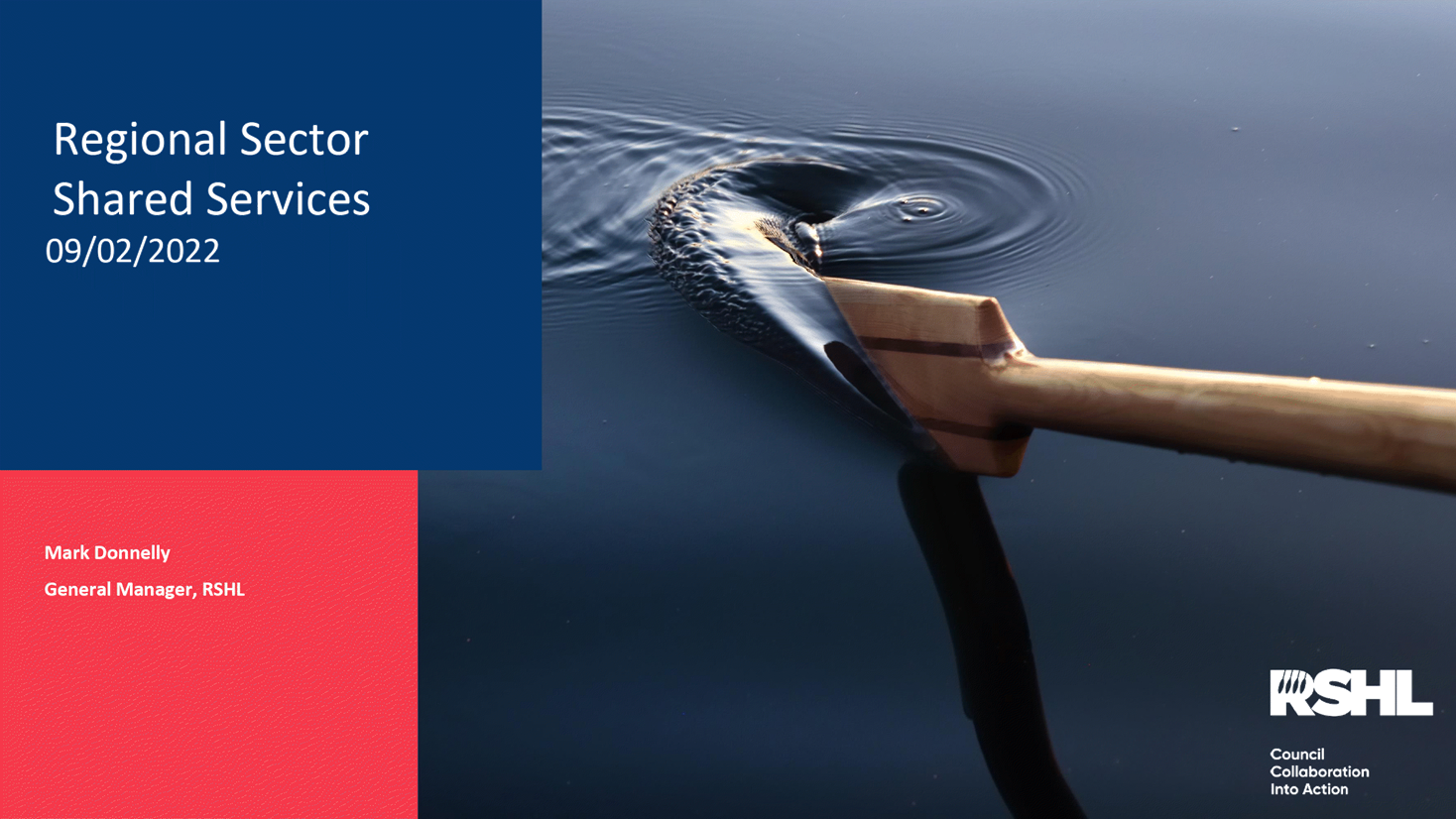

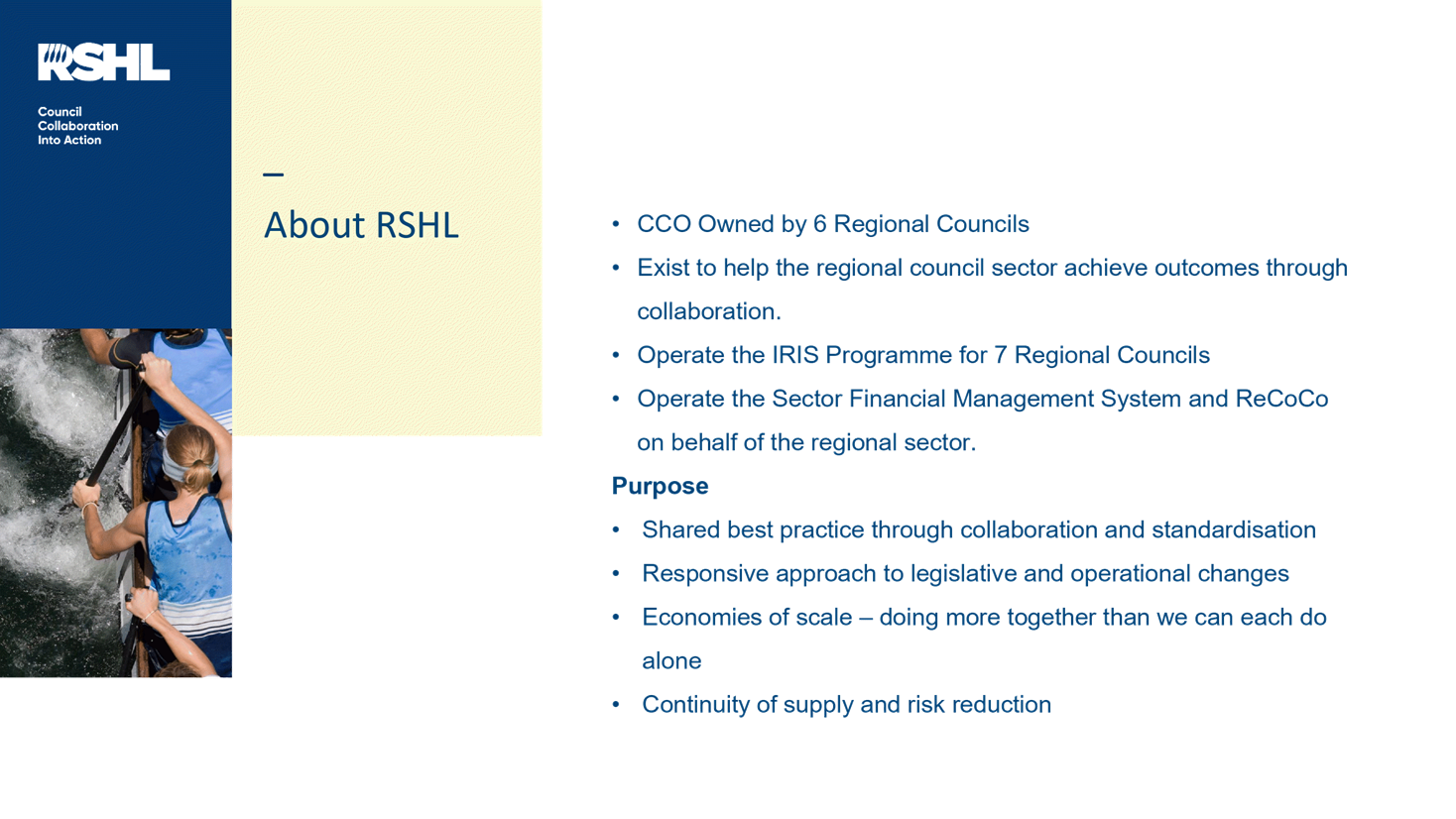


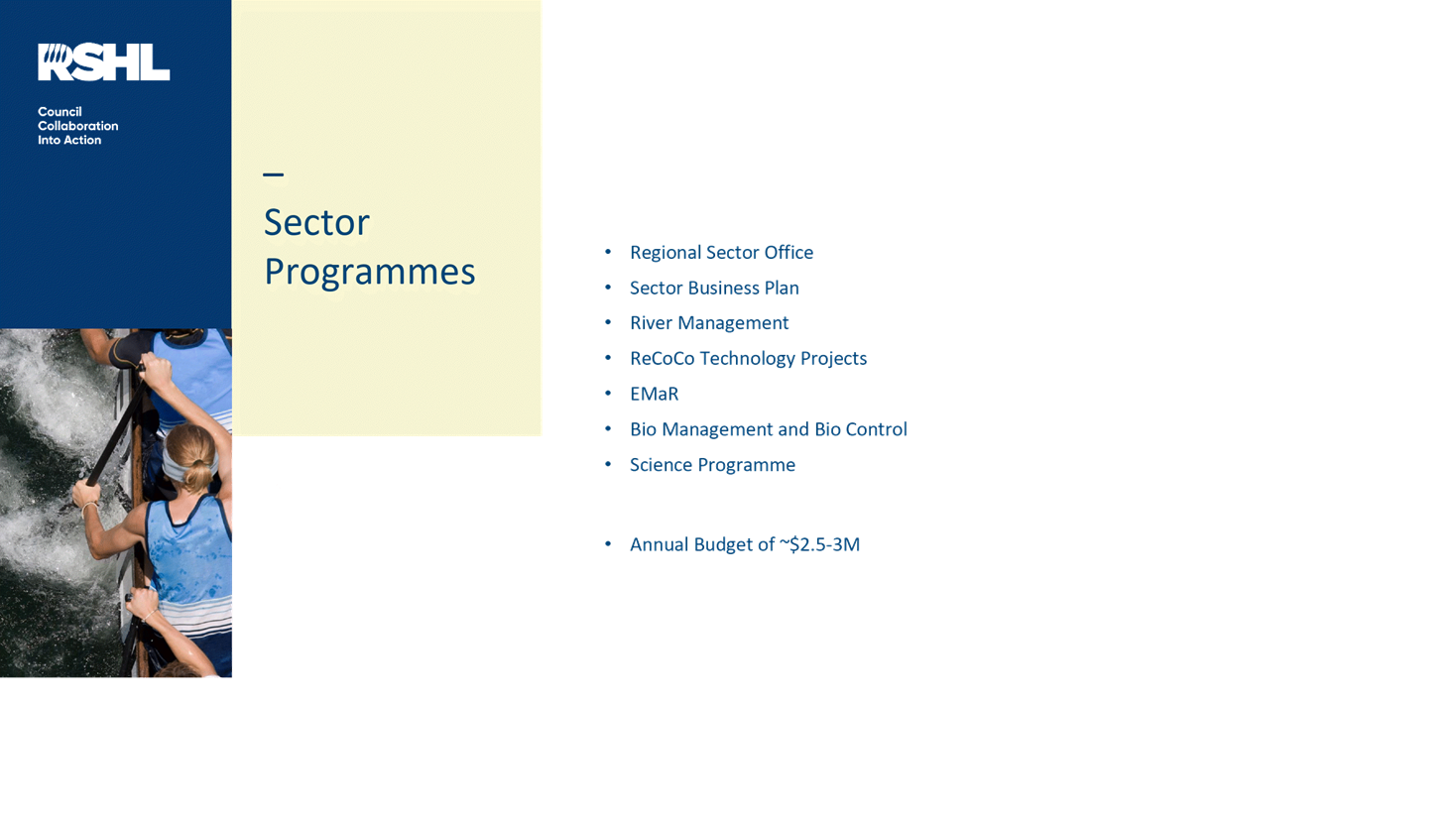


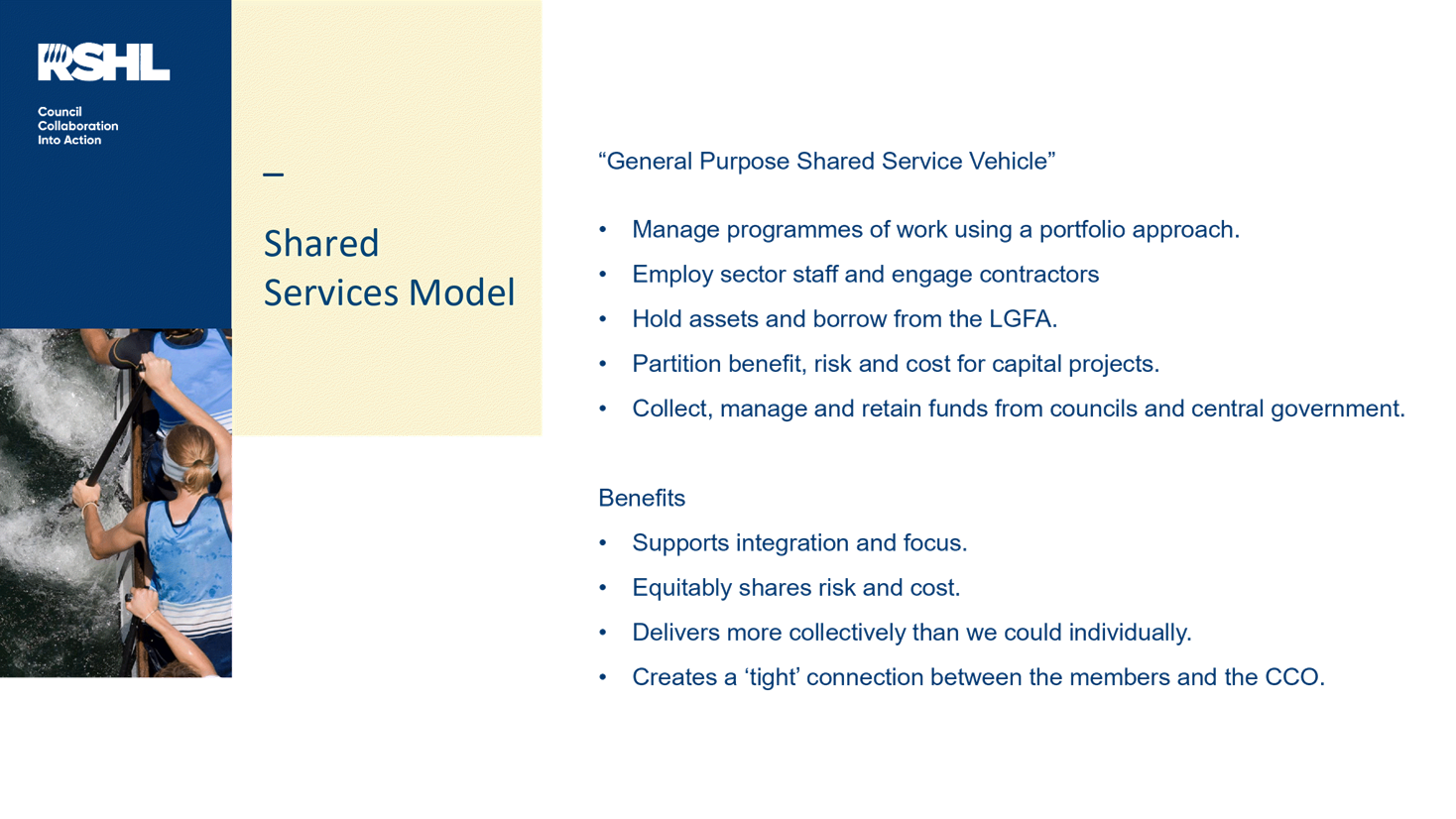


|
HBRC Proportion of Member
Contributions to Shared Services CCO
|
Attachment 2
|
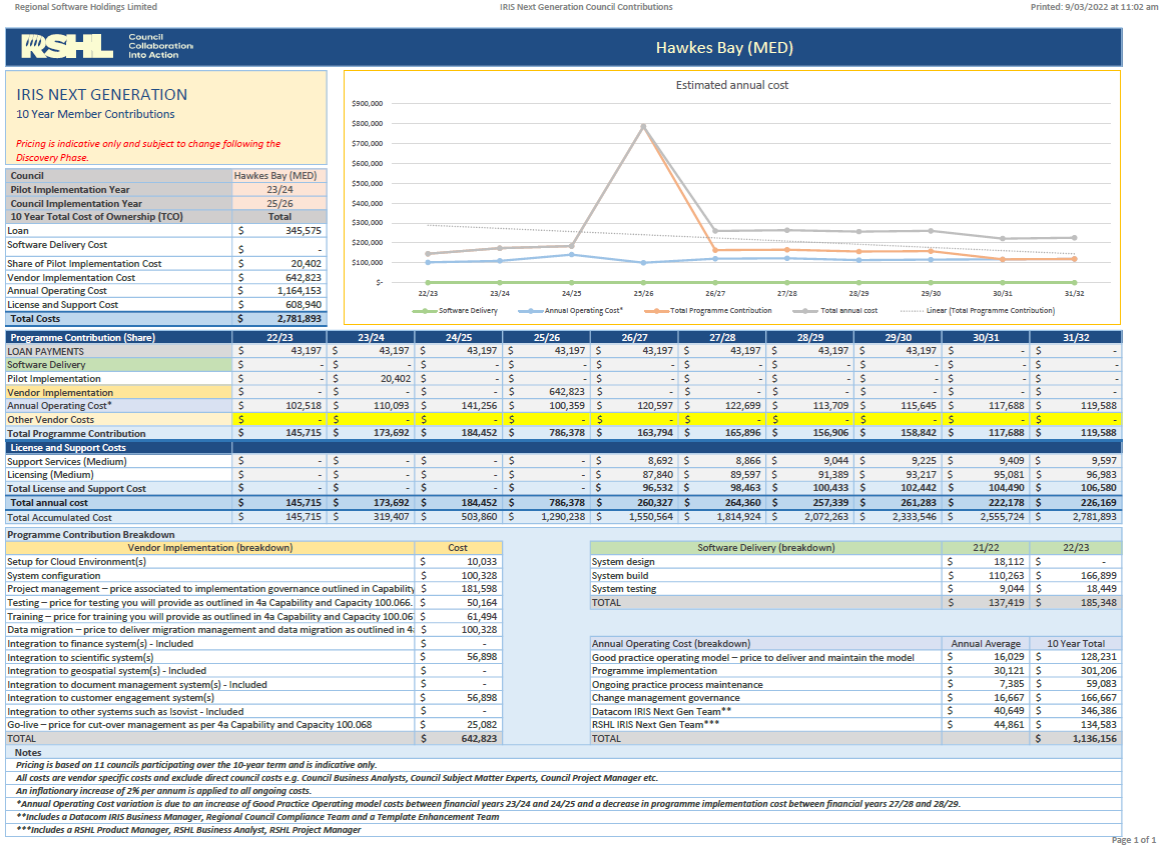
HAWKE’S
BAY REGIONAL COUNCIL
Corporate
and Strategic Committee
16 March
2022
Subject: Updated HBRC Appointment and
Remuneration of Directors Policy
Reason for Report
1. This paper seeks committee
recommendations to Council for amendments to the Policy on the appointment and
remuneration of directors to the Council’s investment company, the
Hawke’s Bay Regional Investment Company (HBRIC), and its subsidiaries, in
order to support changes to the investment mandate of the company made in the
Investment Policy contained within the 2021-2031 Long Term Plan.
Officers’
Recommendations
2. Council officers recommend
a series of amendments to the Appointment and Remuneration of Directors Policy
to clarify the roles of councillors and independent appointees as directors of
HBRIC and its subsidiaries, and thereby ensure that Council’s more active
investment objectives are appropriately governed to support optimum investment
performance, while maintaining appropriate oversight and accountability by
Council.
Executive
Summary
3. The 2021-31 Long Term Plan
included a revised Investment Strategy enabling HBRIC, to grow its investment
portfolio by up to $100m over the next decade. It is therefore likely
HBRIC will expand the number of entities in which it has a shareholding
interest, necessitating decisions on governance representation.
4. HBRIC should continue to be
governed by a blend of commercial and council affiliated directors to support
integrated objectives setting and strategic alignment with Council, while
ensuring the perspectives and expertise of independent commercial directors
complement that of councillor directors. It is recommended that the Policy
states a preference for the Chair of HBRIC to be an independent director.
5. It is recommended that
board fees be payable to councillor directors of HBRIC only in the event they
are until that point remunerated at the base councillor salary rate, and that
remuneration for HBRIC director duties be equivalent to the difference between
the base councillor salary and that of a Council committee chair.
6. HBRIC acts as a holding
company for Council’s investment assets. To maintain separation between
active commercial investment activity and the role of councillors as community
representatives overseeing this activity, it is recommended that the Policy
state that councillors should not be eligible for appointment as directors to
subsidiaries of HBRIC.
7. Transitional arrangements
for Councillors serving on the
boards of two HBRIC subsidiaries, Napier Port and HBRIC CCO FoodEast are
recommended to manage the transition to the new arrangements to minimise
disruption to the relevant commercial entity.
8. It is recommended that the
Policy provide for the appointment of Council executives from time to time to
the board of a CCO to represent its interests in a apolitical manner, where
this provides for particular skills and expertise, or development opportunities
for executives.
9. Following the decisions of
the Corporate and Strategic Committee, council officers will prepare a revised
draft policy to be considered by Council alongside the recommendations of the
committee on 30 March 2022.
Background
/Discussion
10. An Appointment and
Remuneration of Directors Policy (the Policy) is a statutory requirement
regarding the appointment and remuneration of directors to all Council
organisations. Under section 57 of the Local Government Act 2002 (the LG Act),
the Council must adopt a policy that sets out an objective and transparent
process for:
10.1. the identification and
consideration of the skills, knowledge, and experience required of directors of
a council organisation (including consideration of whether knowledge of tikanga
Māori is relevant to
its governance);
and
10.2. the appointment of
directors to a council organisation; and
10.3. the remuneration of
directors of a council organisation.
11. The current policy on Appointment
and Remuneration of Directors was last reviewed and adopted on 22 February
2017, with specific matters related to Napier Port updated in 2019 as part of
the Initial Public Offering.
12. Historically Council was
required to only make appointments of directors to its sole Council Controlled
Trading Organisation HBRIC (which in turn made appointments to its sole
subsidiary Napier Port). Appointments to HBRIC have typically been a mix of
councillor and independent directors.
13. However, the 2021-31 Long
Term Plan (LTP) has enabled HBRIC to grow its investment portfolio and it is
therefore likely that HBRIC will expand the number of entities in which it has
shareholding interest (including the formation of Council Controlled Trading
Organisations, where shareholding interest exceeds or is equal to 50%)
necessitating decisions on governance representation.
14. Following the adoption of
the Investment Strategy in the 2021-31 LTP it was considered timely to review
the governance and remuneration structure for HBRIC and its subsidiaries,
including Council’s policy position around Councillor appointments to
external board / directorship positions and their remuneration.
15. Within the Investment
Strategy Council decided its commercial interests are generally best managed by
its investment company, HBRIC, unless there are good reasons, such as tax
treatment to manage such interests in an alternative manner.
16. Council officers presented
options for amending the Policy to Council workshops on 17 November 2021 and 23
February 2023. In preparation of advice for the workshops reference was made to
industry advice and Office of the Auditor-General (OAG) best practice where
applicable. The recommendations in this paper reflect the direction provided to
officers on amendments to the Policy arising from the workshops.
Options
Assessment
Councillor Directors
17. Council has, until now,
appointed councillors to the board of HBRIC to ensure the company pursues the
strategic investment objectives of Council and undertakes its activities in a
many that is in the best interests of Council and its ratepayers. It is
recommended that Council continues to appoint councillor directors to the board
of HBRIC and the Policy reflects this.
18. At the Council workshops
councillors expressed a preference for HBRIC to continue to be governed by a
blend of commercial and council affiliated directors to support integrated
objectives setting and strategic alignment with Council, while ensuring the
perspectives and expertise of independent commercial directors complement that
of councillor directors HBRIC. This reduces risks to Council by improving the
quality of governance and decision making at the HBRIC board table. Rather than
a balanced board, with equal numbers of councillor and independent directors,
councillors have expressed a preference for flexibility in the composition of
the board of HBRIC. Council officers recommend that the Policy requires a minimum
of two independent directors within an overall maximum of up to 8
directors overall for the board of HBRIC.
19. HBRIC acts as a holding
company for Council’s investment assets, active commercial activity is
undertaken via subsidiaries or funds management, and HBRIC not itself directly engaged in
commercial trading activity.
Councillors have expressed a preference that HBRIC not appoint councillor
directors to HBRIC subsidiaries and CCO’s in the future. This would
maintain separation between active commercial investment activity and the role
of councillors as community representatives overseeing this activity, and
thereby enable the governance of these active investments to be entirely
commercially focussed, with councillors remaining able to hold the investment
entities accountable for their performance without being conflicted. It is
therefore recommended that the Policy state that councillors should not be
eligible for appointment as directors to subsidiaries of HBRIC.
20. Council may make exceptions
to the Policy by formal resolution of Council and there may be special
circumstances in which the appointment of councillors to a HBRIC subsidiary is
deemed necessary or desirable. In the event that Council does suspend the
Policy to enable councillors to be considered for appointment by HBRIC to a subsidiary
company, by resolution in response to special circumstances, it is recommended
that the Policy state that the appointment is to be made by independent
directors of HBRIC. This will ensure councillors being appointed to commercial
entities attracting market-based fees are only appointed following an objective
and apolitical assessment of the suitability of their skills for the role.
21. For reasons of efficiency
and consistent with the purpose of HBRIC, Councillors have indicated that HBRIC
should be delegated the authority to appoint directors to its subsidiaries, in
consultation with Council, and it is recommended that the Policy reflect this.
Skills
22. To maximise the performance
of commercial CCOs, it is essential that CCOs have a skills-based board,
constituted of directors with the relevant industry experience and knowledge,
governance and commercial skills. It is therefore recommended the Policy state
that relevant skills are the most important criteria for all director
appointments
to HBRIC subsidiaries and CCOs.
Independence & Chair
23. Councillor tenure by the
nature of the triennial election process, presents continuity uncertainty that
can be disruptive to a CCO, particularly to a commercial entity. To mitigate
this uncertainty, it is recommended that the Policy states a preference for the
Chair of HBRIC to be an independent director.
24. In the event Council
resolves to appoint a Councillor director to the chair of HBRIC, including on
an interim basis, it is recommended that the Councillor be eligible for
remuneration at the same rate as the independent chair.
Diversity & Transparency
25. It is recommended that the
Policy explicitly states that Council values and supports the benefits that
diversity of thought, experience and skills brought to CCO boards. This
recognises that increasing diversity and fostering inclusive board culture is an
important element in supporting high performing boards, driving long-term
success and delivering better outcomes.
26. It is further recommended
that Council commits to supporting and initiatives that lead to an inclusive
recruitment and selection process for board appointments, which are open and
transparent, uphold Council’s commitments to Equal Employment
Opportunities, and achieve diversity and inclusion.
Councillor Remuneration
27. The OAG recommends as
standard practice that councillor directors receive directors' remuneration in
addition to their remuneration as councillors. A CCO director is responsible
for the governance of the CCO. The position, if discharged properly, involves
work, so remuneration is appropriate.
28. Board members’ fees
will typically compensate board members for their normal contribution to the
board, including attending board and Committee meetings, meeting preparation,
stakeholder management and any other agreed tasks. However, with publicly owned
entities the OAG advises that board members’ fees may reflect the element
of public service in serving on the board of a CCO and be set at or below the
average for comparable private sector entities.
29. In the case of HBRIC,
councillor directors have not received board members’ fees to date, on
the premise that participation in this board has been an extension of the role
of councillors, with HBRIC operating as a supervisory arm of Council. This has
been deemed appropriate with HBRIC acting as a holding company for the Council’s
portfolio of investments, that is not itself directly engaged in commercial
trading activity. However, board duties for HBRIC directors still involve a
regular attendance at board meetings, a substantial volume of board papers and
periodic decision making which can be expected to increase with the more active
investment mandate for HBRIC.
30. At present all HBRIC
councillor directors hold other Council committee chair responsibilities that
attract a higher level of remuneration than the base salary of councillors, as
determined by the Remuneration Authority. Councillors have indicated that they
believe this higher level of remuneration compensates for additional duties,
including directors’ duties on the board of HBRIC. It is therefore
recommended that board fees be payable to councillor directors only in the
event they are until that point remunerated at the base councillor salary rate,
and that remuneration for HBRIC director duties be equivalent to the difference
between the base councillor salary and that of a Council committee chair.
Council Executive Director
Appointments
31. Council may from time to
time wish to appoint a Council executive to the board of a CCO to represent its
interests in a non-political manner, where this provides for particular skills
and expertise, or development opportunities for executives. Council chief
executives are routinely appointed to CCOs around New Zealand to represent
Council interests in a non-political and electorally stable manner. For
example, the Chief Executive of the Bay of Plenty Regional Council is a
director of Quayside Holdings Ltd.
32. It is recommended that the
Policy provide for the appointment of executive directors to HBRIC subsidiaries
and CCOs, and that any directors’ fees such an appointment may attract
should be paid by the subsidiary or CCO to the parent company, unless otherwise
agreed as part of a modified remuneration package for the executive that
reflects adjusted responsibilities and accountabilities.
Transitional arrangements
33. Council is presently
represented by councillors on the boards of two HBRIC subsidiaries, Napier Port
and HBRIC CCO FoodEast, which reflects historic circumstances related to the
Initial Public Offering of shares in Napier Port and the establishment of the FoodEast
entity in partnership with the Crown, Hastings District Council and Progressive
Meats.
34. In light it is recommended
that the councillor director on the Port of Napier board serves the remainder
of this term to the Annual General Meeting of Napier Port in December 2022 to
enable an orderly transition to a new non-councillor director. With respect to
FoodEast, it is recommended that the councillor director continue their board
role until completion of the establishment stage and a decision is made to
commence construction of the FoodEast facility.
35. Both councillor directors
of these CCTOs have undertaken significant work in addition to their councillor
duties, as well as taking on significant commercial and legal responsibilities,
in their HBRIC subsidiary board roles. It is therefore recommended that they be
eligible for payment of full board fees as determined by their respective
boards for work undertaken to date and for the remainder of their terms.
Port of Napier
36. Prior to the Initial Public
Offering (IPO) of shares in Napier Port directors of the company were appointed
by HBRIC, in consultation with Council. As part of the IPO process
Council resolved to maintain board representation of the strategic interests of
the region and regional ratepayer as the majority shareholder. Council resolved
to nominate two directors for appointment by the shareholder of the company at
the applicable Annual General Meeting.
37. To ensure Council
visibility of the board’s decision making and governance of the Port
through the transition to a public company Council nominated a Councillor and a
council affiliated commercial director in 2019.
38. It is recommended that the
Policy be amended to state that Council will nominate two directors to the
board of Napier Port for as long as a majority shareholding is held by Council
via HBRIC.
Strategic Fit
39. Leveraging the
Council’s balance sheet and taking a more active approach to
Council’s investment activity is an important element of the
Council’s overall financial strategy to fund more activity to achieve
greater impact in the Council’s strategic outcome areas. This paper
supports these objectives.
Significance
and Engagement Policy Assessment
40. Council officers have
assessed the significance of the decisions in this report as being low and
therefore not requiring community engagement.
Climate
Change Considerations
41. There are no specific
climate change considerations related to the policy proposed for amendment in
this paper. However, the Council has specific climate change related objectives
within its investment strategy and the maintenance of councillor director
influence on the board of HBRIC assists in ensuring the Council’s
strategic objectives in this regard are achieved.
Considerations
of Tangata Whenua
42. There are no direct
considerations for tangata whenua arising from this paper. The recommended
inclusions in the Policy, with respect to diversity and transparency, are
intended to create opportunities for Te Ao Maori perspectives to be brought to
the governance of HBRIC and its subsidiaries.
Financial
and Resource Implications
43. There are no direct
financial implications arising from this report. Director remuneration is
provided via revenue generated from the investment activity that is governed by
the directors. A high standard of governance arrangements assists in managing
risks to the Council’s investment portfolio and protecting asset values
and revenues.
Consultation
44. Consultation is not
required for the decisions in this paper as they relate to administrative
arrangements to facilitate the more substantive matter of Council’s
investment strategy that was consulted upon as part of the 2021-2031 Long Term
Plan.
Decision Making Process
45. Council and its committees
are required to make every decision in accordance with the requirements of the
Local Government Act 2002 (the Act). Staff have assessed the requirements in
relation to this item and have concluded:
45.1. The decision does not
significantly alter the service provision or affect a strategic asset, nor is
it inconsistent with an existing policy or plan.
45.2. The use of the special
consultative procedure is not prescribed by legislation.
45.3. The decision is not
significant under the criteria contained in Council’s adopted
Significance and Engagement Policy.
45.4. The persons affected by
this decision are all ratepayers and residents as beneficiaries of the
Council’s investment portfolio.
45.5. Given the nature and
significance of the issue to be considered and decided, and also the persons
likely to be affected by, or have an interest in the decisions made, Council
can exercise its discretion and make a decision without consulting directly
with the community or others
having an interest in the decision.
Recommendations
1. That the Corporate and
Strategic Committee:
1.1. receives and considers the Updated HBRC Appointment and Remuneration of Directors
Policy staff report.
1.2. Agrees the Appointment and
Remuneration of Directors Policy be amended to reflect the following
preferences.
1.2.1. HBRIC should continue to be
governed by a blend of commercial and councillor directors to support
integrated objectives setting and strategic alignment between Council and
HBRIC, while incorporating independent perspectives and commercial skills, with
a minimum of two independent directors within an overall maximum of eight
directors.
1.2.2. Councillor directors are to
be paid for their director duties on the board of HBRIC only if they are not
already remunerated for higher duties as Council committee chairs or Council
Chair or Deputy, and in such event are to be paid the difference between a base
councillor salary and that of a Council committee chair.
1.2.3. In the event a Councillor
director is appointed Chair of HBRIC, remuneration should be equivalent to that
which would be paid to an Independent Chair.
1.2.4. HBRIC’s commercial
subsidiaries should be run for commercial objectives by independent directors only,
in order to maintain separation between active commercial investment activity
and the role of councillors as community representatives overseeing this
activity via HBRIC and Council, enabling councillors to hold the investment
entities accountable for their performance without being conflicted.
1.2.5. In the event that Council,
by resolution, suspends the Policy in respect of 1.2.4 above and enables
councillors to be considered for appointment by HBRIC to a subsidiary company
in response to special circumstances, the appointment is to be made by
independent directors of HBRIC to ensure councillors being appointed to
commercial entities attracting market-based fees are only appointed following
an objective and apolitical assessment of the suitability of their skills for
the role.
1.2.6. Commercial subsidiaries and
CCOs must have skills-based boards, constituted of directors with the relevant
industry experience and knowledge, governance and commercial skills.
1.2.7. All boards of entities for
which HBRIC holds significant shareholdings are required to consider how they
support diversity and inclusion, with open and transparent appointment processes.
1.2.8. HBRIC is delegated the
authority to appoint directors to its subsidiaries in consultation with Council.
1.2.9. The Chair of HBRIC should
be an Independent Director.
1.2.10. Board fees should be paid
for all non-councillor Director positions, and that Council supports payment of
market-based fees.
1.2.11. Existing councillor
directors on HBRIC subsidiaries should stand down from their roles in a managed
transition that minimises disruption to the commercial interests of their
entities, and Council with board fees paid for all work to that point.
1.2.12. In consultation with
Council, HBRIC may appoint executive directors to HBRIC subsidiaries with
directors’ fees paid by the subsidiary or CCO to the parent company,
unless otherwise agreed as part of a modified remuneration package for the
executive that reflects adjusted responsibilities and accountabilities.
1.2.13. Council will nominate two
directors for the board of Napier Port for as long as a majority shareholding
is held by Council via HBRIC.
1.3. Instructs Council officers
to provide a revised Appointment
and Remuneration of Directors Policy to the Council meeting on 30 March 2022
that incorporates the amendments resolved in 1.2.1 through 1.2.13 above.
2. The Corporate and Strategic
Committee recommends that Hawke’s Bay Regional Council:
2.1. Agrees that the decisions
to be made are not significant under the criteria contained in Council’s
adopted Significance and Engagement Policy, and that Council can exercise its
discretion and make decisions on this issue without conferring directly with
the community or persons likely to have an interest in the decision.
2.2. Adopts the Appointment and
Remuneration of Directors Policy as amended to incorporate the Corporate and
Strategic Committee’s preferences resolved by resolutions 1.2.1 through
1.2.13 above.
Authored by:
|
Desiree Cull
Strategy & Governance Manager
|
Kishan Premadasa
Management Accountant
|
Approved by:
|
Jessica Ellerm
Group Manager Corporate Services
|
James Palmer
Chief Executive
|
Attachment/s
There are no attachments for this
report.
HAWKE’S
BAY REGIONAL COUNCIL
Corporate
and Strategic Committee
16 March
2022
Subject: HBRIC and Foodeast Draft
Statements of Intent
Reason for Report
1. This item presents the
draft Statement of Intent for Hawke’s Bay Regional Investment Company
(HBRIC) and Foodeast Limited Partnership (Foodeast) for the Committee’s
feedback.
Background
/Discussion
2. To meet Local Government
Act 2002 (LGA) legislative timeframes, HBRIC and Foodeast are required to
submit their Draft Statement of Intent (SoI) to Council (as shareholder and
local authority with indirect control). The Draft SoIs, which outline the
CCO’s role, strategic direction and objectives for the year ahead, were
approved by the respective Boards in February (Attachments 1 & 2).
3. The Committee is asked to
provide feedback to HBRIC and Foodeast on amendments to be considered for
incorporation into the final Statement of Intent.
4. In accordance with the LGA,
HBRIC and Foodeast are required to consider any comments received from Council
prior to submitting the final SoI for Council’s approval by 30 June each
year.
HBRIC
SoI
5. There have been no
significant changes to the SoI from the 2021-2022 year.
6. The HBRIC Board recently
approved the company’s investment framework and strategy and will present
this to Council in the near future.
7. The Board is focused on
growing and diversifying investment returns in the coming years.
8. Distributions to
Shareholder have been presented as a range ($8-11m). The HBRIC Board is
confident of delivering dividends within these target ranges, noting that
dividend payments to Council are dependent on future market and trading
conditions that Napier Port Holdings Ltd may encounter.
9. Council’s Annual Plan
dividend expectation from HBRIC for the FY2022-23 year is $10.5m which is
within the SoI range, albeit the upper end.
10. HBRIC’s Chairman will
be present to answer questions.
Foodeast
SoI
11. Following a review of the
Foodeast SoI, the Directors of HBRIC intend to provide the below feedback to
Foodeast. It is recommended that the Committee provides any additional feedback
on the Foodeast SoI to HBRIC, so that it can be included with HBRIC’s
feedback to Foodeast.
11.1. Page 5, section 4, Vision:
recommend adding “to create 500+ jobs and add over $100m to the Gross
Domestic Product (GDP) for the Hawke’s Bay region”
11.2. Page 5, section 6, Purpose:
recommend shortening the purpose to be “To construct and operate a food
innovation hub, whilst making a commercial return consistent with the
requirements of its shareholders and as outlined in Foodeast’s Limited
Partnership Agreement”
11.3. Page 6-7, Financial
Performance Targets: recommend adding a target to generate commercial returns
equalling a minimum of 6% per annum (capital gains and income) over time, consistent
with the requirements of the majority shareholder Hawke’s Bay Regional
Investment Company
11.4. We note the project is
working through the impact of cost inflation associated with the construction
sector, which has delayed the development. Please provide an update on the
status of construction planning and any impact on shareholders associated with
the development as part of the final SOI.
Decision Making Process
12. Council and its committees
are required to make every decision in accordance with the requirements of the
Local Government Act 2002 (the Act). Staff have assessed the requirements in
relation to this item and have concluded:
12.1. The Statements of Intent
for HBRIC Ltd and Foodeast are required to be prepared under section 64 of the
Local Government Act 2002. This is a statutory requirement and is not subject
to consultation under the provisions of the Act.
12.2. Given the nature and
significance of the issue to be considered and decided, and also the persons
likely to be affected by, or have an interest in the decisions made, Council
can exercise its discretion and make a decision without consulting directly
with the community or others
having an interest in the decision.
Recommendations
1. That the Corporate and
Strategic Committee receives and considers the HBRIC and Foodeast Draft
Statements of Intent staff report, with agreed feedback to the HBRIC Board of Directors
for potential incorporation into the final 2022-2023 Statement of Intent.
If
required
2. Agreed feedback being:
2.1. That the HBRIC Statement of
Intent is edited to include …
2.2. That the Foodeast Statement
of Intent is edited to include …
3. The Corporate and Strategic
Committee recommends that Hawke’s Bay Regional Council:
3.1. Agrees that the decisions
to be made are not significant under the criteria contained in Council’s
adopted Significance and Engagement Policy, and that Council can exercise its
discretion and make decisions on this issue without conferring directly with
the community or persons likely to have an interest in the decision.
3.2. Further considers the HBRIC
Ltd 2022-2023 draft Statement of Intent (SoI) and undertakes to provide any
additional feedback on the Draft SoI to HBRIC Ltd by 1 May 2022 (LGA Sch8 cl3)
to enable delivery of the completed Statement of Intent to Council on or before
30 June 2022 for adoption.
Authored
by: Approved
by:
|
Kishan Premadasa
Management Accountant
|
Jessica Ellerm
Group
Manager Corporate Services
|
Attachment/s
|
1⇩
|
HBRIC Draft Statement of Intent
2022-2023
|
|
|
|
2⇩
|
Foodeast
Draft Statement of Intent 2022-2023
|
|
|
|
HBRIC Draft Statement of Intent 2022-2023
|
Attachment
1
|
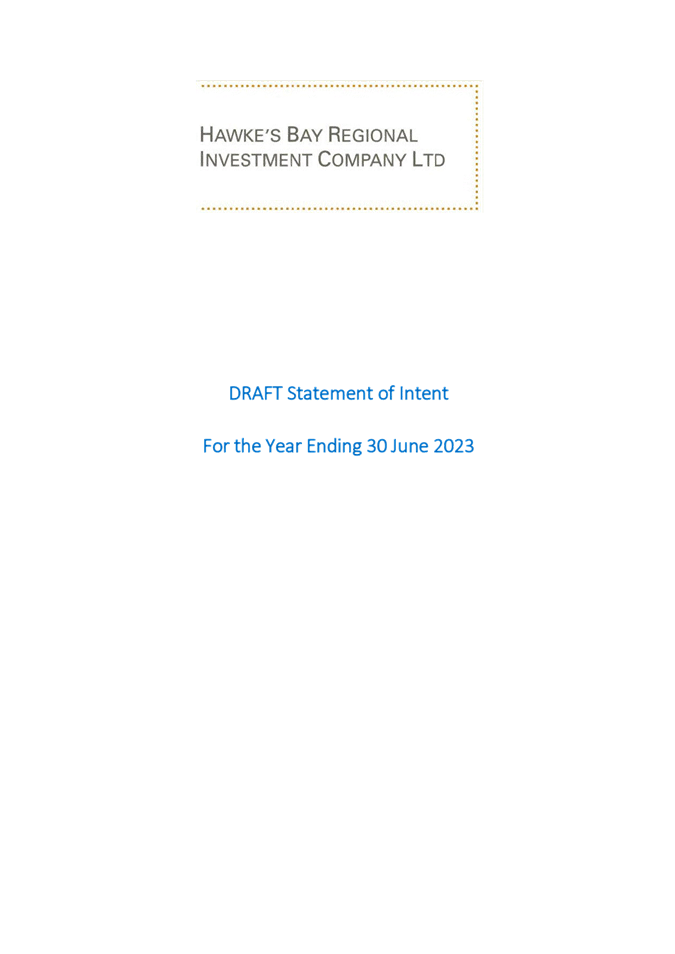


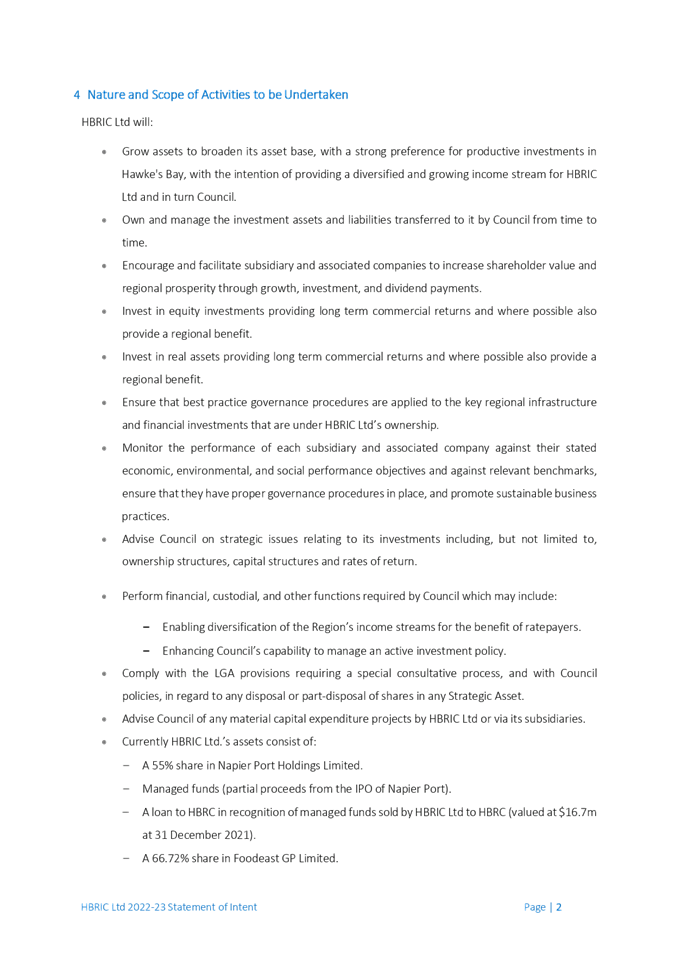


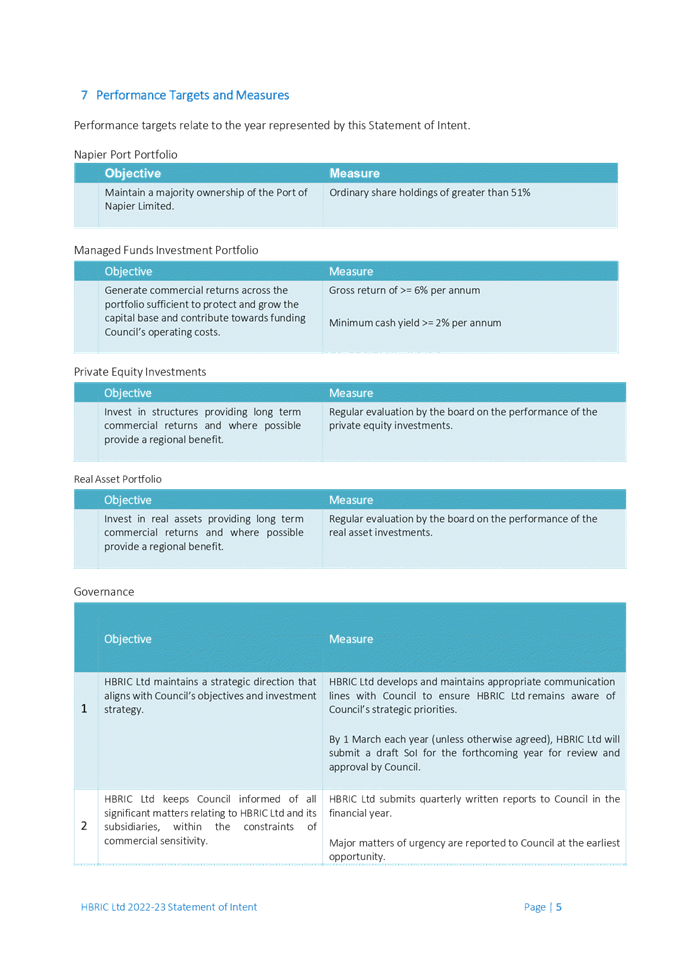
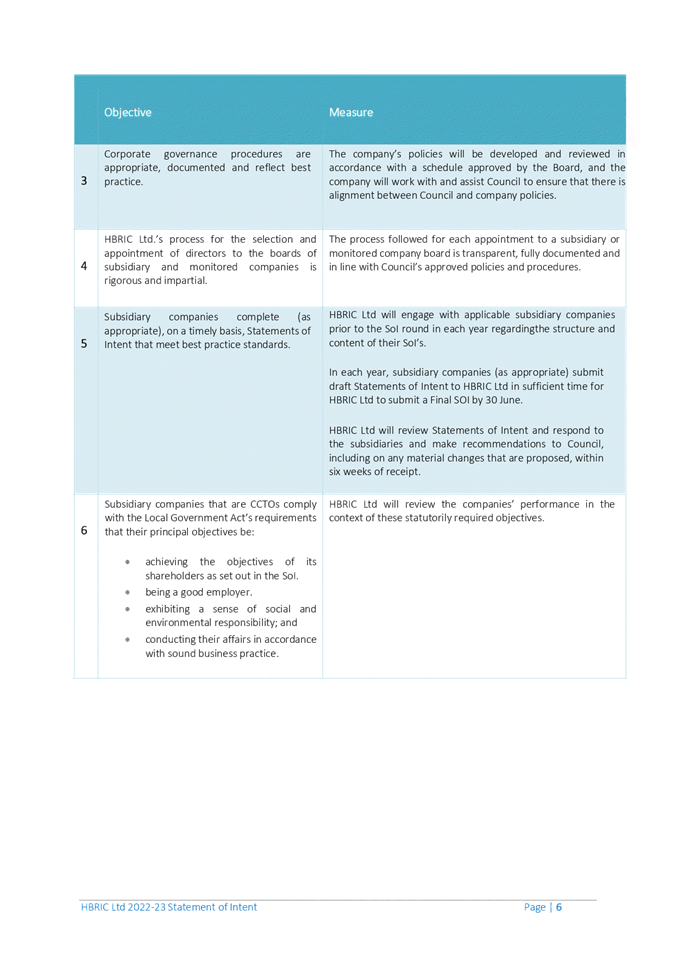
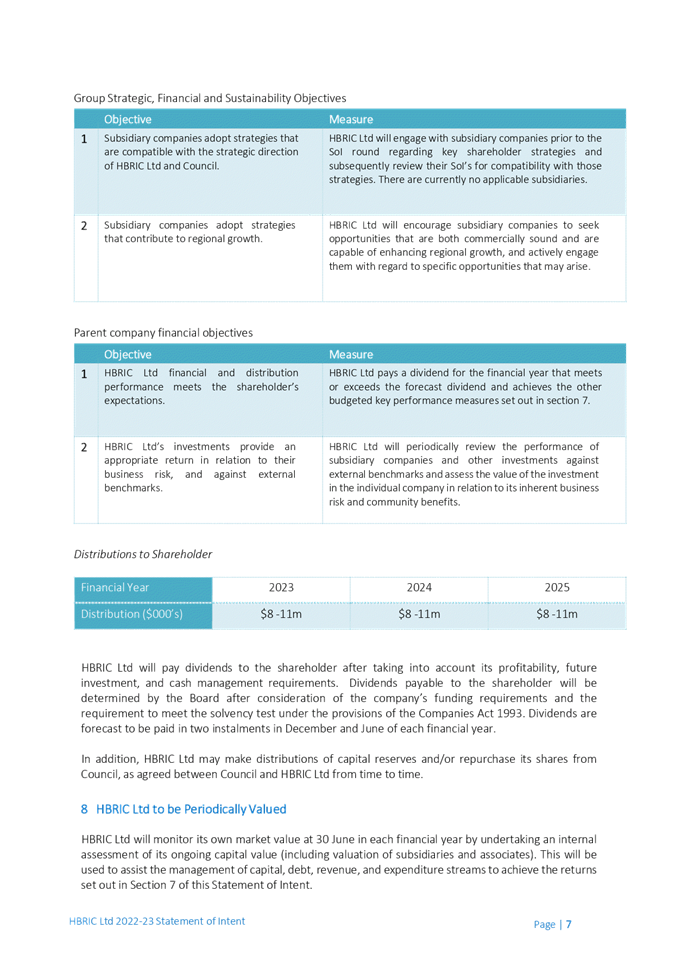


|
Foodeast Draft Statement of Intent 2022-2023
|
Attachment
2
|





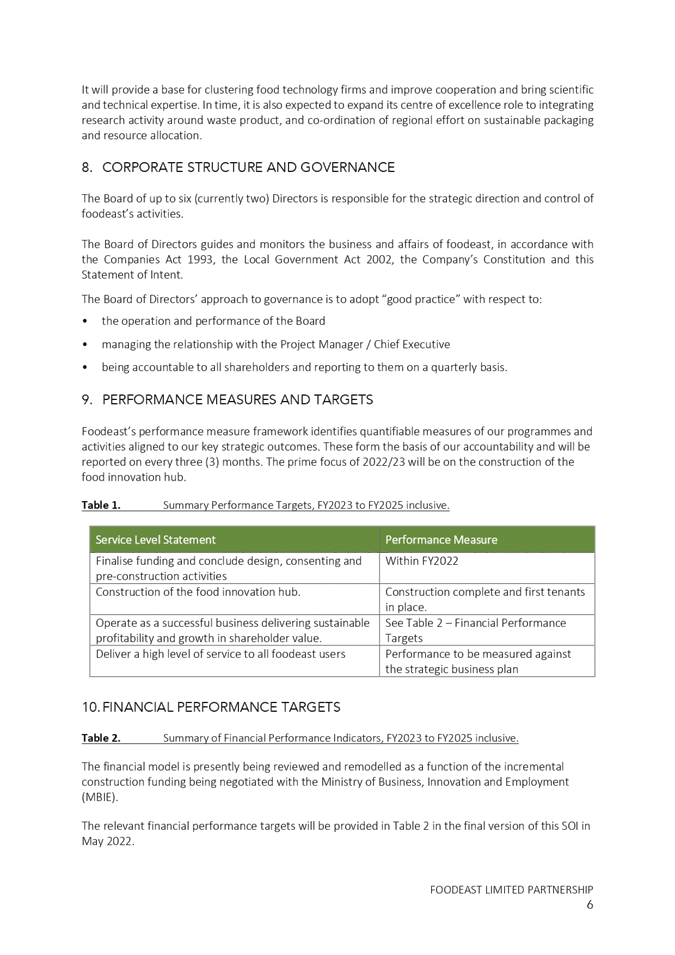







HAWKE’S
BAY REGIONAL COUNCIL
Corporate
and Strategic Committee
16 March
2022
Subject: HBRIC Quarterly Update
Reason for Report
1. This item provides Council
with a quarterly update on the activities of Hawke’s Bay Regional
Investment Company (HBRIC) for the second quarter of
the FY2021-22 financial year.
Financial Reporting
2. HBRIC’s Financial
Statements for the half year ending 31 December 2021 are attached to this
report.
3. Key Items to note:
3.1. Statement of Financial
Performance – Surplus of $5.2m (excluding fair value movements through
other comprehensive income)
3.2. Statement of Financial
Performance – $5.1m of dividend revenue received from Napier Port
Holdings Limited (NPHL) in December 2021
3.3. Other Comprehensive Income
– Loss of $33m, driven by a drop in the NPHL share price (loss on
revaluation)
3.4. Statement of Financial
Position – A reduction in net assets by $30m due to the drop in NPHL
share price
3.5. Net Assets of $415m as at
31 December 2021.
Managed Funds
4. The funds remain under management
in compliance with Council’s Statement of Investment Policy and
Objectives (SIPO).
5. The value of managed funds
with HBRIC as at 31 December 2021 amounted to $48.9m, a movement of
approximately +$1.7m (3.5%) year to date.
6. In December 2021, HBRIC
divested $1.3m from the managed funds after protecting its capital value.

HBRIC Capital Structure
7. The Board of HBRIC is
continuing to progress the development of a clear capital structure and
investment mandate to support the growth of the company, as agreed with
Council. When
this is finalised, it will be shared with Council.
Foodeast
8. HBRIC has
invested $1.7m of its planned $4m investment, with further capital drawdowns to
occur during the life of the investment.
9. The project has
encountered construction cost inflation above budget, upon receipt of the final
construction tender. This has resulted in a delay to the commencement of
construction, while re-design work is undertaken.
10. A further update will be
provided in the next quarterly update.
Napier Port
11. In November
Napier Port reported on its full financial year ended September 2021.
12. For the year
revenue rose 9% to $109.5m from $100.4m in the prior year, driven by record log
exports of 3.02 million tonnes.
13. Underlying Net
Profit after tax increased 7% to $22m from $20.5m and Reported Net Profit after
tax increased 5.2% to $23.2m.
14. A final
dividend of 4.7 cents per share (cps,) was declared, totalling 7.5 cps for the
2021 financial year, up from 5 cps for the prior year.
15. Napier
Port’s annual report is available at: https://www.napierport.co.nz/corporate/annual-reports/.
16. For the first
quarter to December 2021 compared to the same period in the prior year, trade
volumes increased 3.4% for bulk cargo led by increased log exports.
Containerised cargo volume decreased by 7.7%, principally due to less container
repositioning activity and continued container shipping schedule disruption.
17. The share price
has fluctuated throughout the year, driven by global/local equity markets and
rising interest rates, contrary to the Port’s positive underlying
operating performance.
18. No. 6 Wharf is
more advanced than the original timeline; it’s now expected to be
operational in the second half of the 2022 financial year and the expected cost
has reduced from $173m to $179m (previously up to $190m).
19. Continuation of
container-based supply chain and shipping disruptions is expected and there is
potential for log export market driven volume volatility during 2022.
20. The Port has
introduced robust COVID response plans, including mandatory vaccinations and
testing regimes.
21. The kororā
sanctuary had a strong 2021-2022 breeding season in 2021 with 13 chicks
successfully fledging by the new year, occupying up to eight nesting boxes at
one time.
HBRIC Name Change
22. HBRIC received
endorsement and feedback from the Māori Committee on 2 February 2022 for a
proposal to re name/ rebrand HBRIC to Te Matau Investments Ltd.
23. The next step
for HBRIC is to develop a brand logo and typography, incorporating the feedback
from the Māori Committee. Options will be presented to the Māori
Committee and Council when completed.
Decision Making Process
24. Staff have assessed the
requirements of the Local Government Act 2002 in relation to this item and have
concluded that, as this report is for information only, the decision making
provisions do not apply.
Recommendation
That
the Corporate
and Strategic Committee receives and notes the HBRIC Quarterly Update.
Authored by:
|
Kishan Premadasa
Management Accountant
|
|
Approved by:
|
Jess Ellerm
Group Manager Corporate Services
|
|
Attachment/s
|
1⇩
|
Statement of Financial Performance
December 2021
|
|
|
|
2⇩
|
Statement of Financial Position
December 2021
|
|
|
|
Statement of Financial Performance
December 2021
|
Attachment
1
|

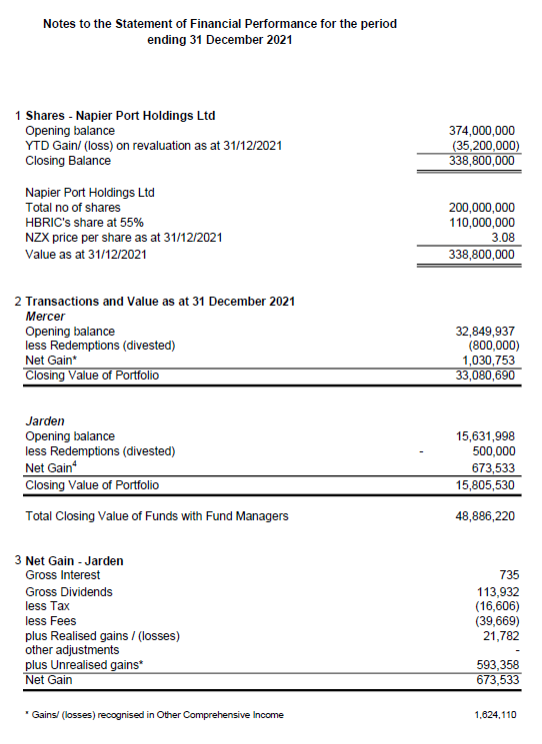
|
Statement of Financial Position December 2021
|
Attachment
2
|
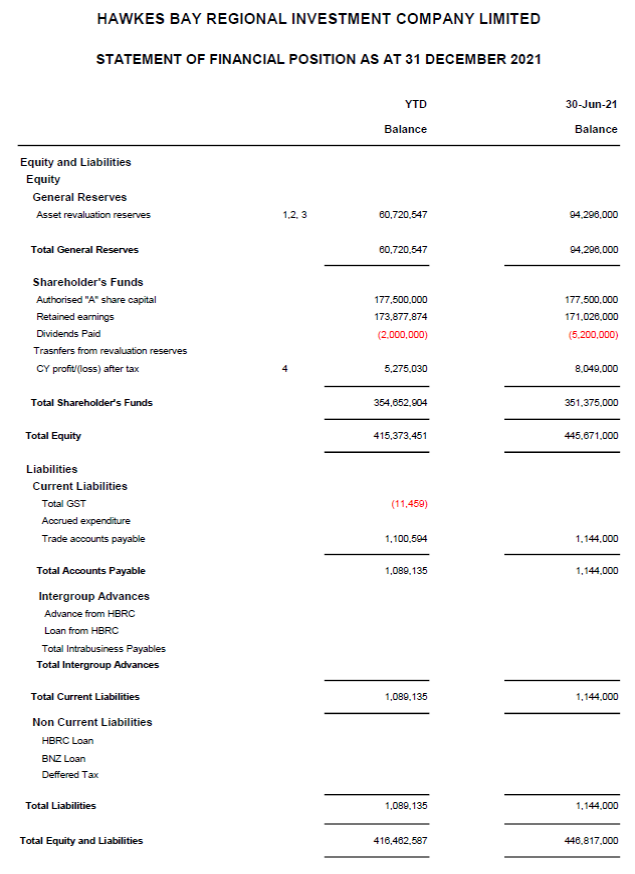


HAWKE’S BAY REGIONAL
COUNCIL
Corporate
and Strategic Committee
16 March
2022
Subject: Report from the Finance Audit
and Risk Sub-committee Meeting
Reason for Report
1. The following matters were
considered by the Finance, Audit and Risk Sub-committee (FARS) meeting on 2
March 2022 and are now presented for the Committee’s consideration
alongside any
additional commentary the Sub-committee Chair wishes to offer.
Agenda
items
2. The Six-Monthly Enterprise Risk
Report item provided the sub-committee with the six-monthly update of
Council’s enterprise risk profile. Discussions noted:
2.1. Risk is defined as
‘the effect of uncertainty on objectives’. The breadth and
depth of external uncertainties are resulting in several emerging risks
impacting all risk types (operational, strategic and financial) for Council.
Therefore the overall residual risk profile for Council has increased despite
implementing additional controls in response to the uncertainties.
2.2. Uncertainties highlighted
include:
2.2.1. regulatory change
2.2.2. Covid19 outbreak with
illness and isolation requirements impacting staff availability and supply
chains, low unemployment rates and the competitive domestic labour market
2.2.3. domestic economic outlook
with increases in inflation and interest rates
2.2.4. increasing geo-political
tensions and the impact on financial markets and fuel prices
2.2.5. climate change action
delays as the world responds to immediate risks of pandemic, and global
economic instability (including asset bubbles).
2.3. The residual risk ratings
elevated from the previous six-monthly report included:
2.3.1. Risk 2 – Financial
(increased from low to medium)
2.3.2. Risk 8 – Business
Interruption (increased from low to high)
2.3.3. Risk 9 – People
Capability (increased from medium to high).
3. The Risk Maturity Update item provided an update to the sub-committee on the
implementation of the risk framework across the business. Discussions noted
that:
3.1. Risk maturity is now
focussed on delivery of phase four, the final phase, of the risk maturity
roadmap. However, in response to current levels of business interruption
and staff resourcing pressures the focus will shift from each Group developing
a risk profile for risk aggregation to the Risk Team working collaboratively
with the Strategy and Performance Team to strengthen risk and performance
metrics within the Organisational Performance report.
3.2. The FARS expressed concerns
around the ability for the current risk system to aggregate risks from the
operational business that relate to key service deliverables. In
response, management will consider the feasibility of commencing the
development of Group Risk profiles over the next reporting period focussing
specifically on the enterprise ‘Risk 3 People, Community and
Environmental Health’.
4. The Internal Audit
Annual Plan Status Update FY2021-2022 item noted that
progress on the FY21-22 annual internal audit plan is on track with the Fraud
Management internal audit in progress and scheduled for presentation to the May
2022 FARS meeting.
5. The Annual Internal
Assurance Plan 2022-2023 item discussions noted the Council’s
‘Audit Universe’ and coverage of previous assurance reviews against
the Enterprise Risks. The final draft of the Annual Internal Assurance
Plan will be present to the FARS at the May 2022 meeting for approval.
Council’s internal auditors, Crowe, will attend the May meeting to
discuss recommendations and provide more details on audit trends.
6. The 2020-2021 Annual
Report Audit Update
item on
the status of the Audit of Council’s annual report was discussed in a
Public Excluded session with the auditor, Karen Young, and is covered in the Public
excluded report from the FARS agenda item.
7. The Quarterly Treasury Report
for 1 October – 31 December 2021 item discussions highlighted:
7.1. For the quarter to 31
December 2021, HBRC was compliant with all measures in its Treasury policy
except for the Mercer SIPO investment allocation, which has since been
corrected.
7.2. There is a strong cash
position due to timing of the rates collection, and lower than planned
borrowing. As Council progresses further into the financial year
additional borrowing will be required.
7.3. Investment returns for the
first 6 months met budget expectations, however, due to market volatility and a
significant financial market adjustment in January 2022, it is too early to
predict the returns for the full financial year. The fluctuation in January
erased most of the gains of the first 6 months so a recovery in the markets is
required to deliver target returns for the year. Staff advice is to watch
and wait, corrective action is not required, and the portfolio is well balanced
for the long term.
7.4. The Council’s overall
cash position is strong, and operational and capital expenditure is behind
budget for the 6 months to 31 December. The full year net funding
requirement will be forecast and commentary provided to the 1 June Corporate
and Strategic Committee meeting.
8. The Scope for Fund
Manager Review
item discussions
covered:
8.1. Feedback to staff on
frequency and criteria for a review of the fund managers
8.2. Interest in a review of the
fund managers’ performance compared to their peers and a review to test
the fees / fee structures
8.3. FARS feedback will be
incorporated and an updated Scope presented to the 10 August 2022 FARS meeting
for agreement to undertake the review.
9. The HBRC Forestry Update
and Tūtira Mānuka Plantation Update items (Attachment 1)
provided the sub-committee with background, current status and objectives of
these assets. Sub-committee
discussions included:
9.1. Investments for soil
erosion, carbon and biodiversity benefits as well as commercial.
9.2. Requests for additional
information regarding linkages between lessons learned from the HBRC forests
and mānuka
plantation to the Right Tree, Right Place Project and fire risk management in HBRC forests
(additional information in Attachment 2).
9.3. The need for a Carbon
Policy was noted. Development of a Carbon Policy is a priority for the Finance
team. The CFO is to identify an owner and resource to undertake this work and
report progress to the next committee meeting.
10. The Internal Assurance
Dashboard - Corrective Actions Status Update item noted:
10.1. In general significant
progress has been made by the business to respond to previous internal audits
with many actions closed.
10.2. Particular attention was
paid to individual internal audit findings where corrective action progress is
tracking red.
11. The Talent Management
Internal Audit Update
item
provided the sub-committee
with an update on addressing the recommendations from the internal audit and commentary is included
in the Public
excluded report from the FARS agenda item.
Decision Making Process
12. Staff have assessed the
requirements of the Local Government Act 2002 in relation to this item and have
concluded that:
12.1. All items were considered
at the Finance, Audit and Risk Sub-committee in accordance with the Terms of
Reference, specifically in relation to the 2 March 2022 meeting, its delegated responsibility and
authority to:
12.1.1. Conduct a sub-committee
members-only session with Audit NZ to discuss any matters that the auditors
wish to bring to the sub-committee’s attention and/or any issues of
independence (6. 2020-2021 Annual Report Audit Update)
12.1.2. Review the objectives and
scope of the internal audit function, and ensure those objectives are aligned
with Council’s overall risk management framework (4. Internal
Audit Annual Plan Status Update FY2021-2022 and 5. Annual Internal Assurance Plan
2022-2023)
12.1.3. Ensure that recommendations
in audit management reports are considered and, if appropriate, actioned by
management (11. Internal Assurance Dashboard - Corrective Actions Status
Update, 12. Talent Management Internal Audit Update and PE. Internal
Assurance Dashboard – Cyber Security Corrective Actions Status Update)
12.1.4. Review whether Council
management has a current and comprehensive risk management framework and
associated procedures for effective identification and management of the
council’s significant risks in place (2. Six Monthly Enterprise
Risk Report
and 3. Risk Maturity Update)
12.1.5. Undertake periodic
monitoring of corporate risk assessment, and the internal controls instituted
in response to such risks (2.
Six
Monthly Enterprise Risk Report)
12.1.6. Monitor the performance of
Council’s investment portfolio (7. Quarterly Treasury Report
for 1 October – 31 December 2021, 8. Scope for Fund Manager Review and 9.
HBRC Forestry Update and Tūtira Mānuka Plantation Update)
12.2. This item is for reporting
purposes in accordance with the Finance, Audit and Risk Sub-committee Terms of
Reference, specifically to report to the Corporate and Strategic
Committee to fulfil its responsibilities for:
12.2.1. The provision of
appropriate controls to safeguard the Council’s financial and
non-financial assets, the integrity of internal and external reporting and
accountability arrangements
12.2.2. The independence and
adequacy of internal and external audit functions
12.2.3. The robustness of risk
management systems, processes and practices.
12.3. This item is for
information and noting only; there are no decisions required, and therefore the
LGA decision making provisions do not apply.
|
Recommendations
1. That the Corporate and
Strategic Committee receives and notes the report from the Finance, Audit and
Risk Sub-committee, including the sub-committee recommendations, being that
the Finance, Audit and Risk Sub-committee:
Six
Monthly Enterprise Risk Report
1.1. Reports to the Corporate
and Strategic Committee, the sub-committee’s satisfaction that the Six-Monthly
Enterprise Risk Report provides adequate evidence of the robustness of
Council’s risk management policy and framework and progress to
implement the maturing risk management system.
Risk
Maturity Update
Reports
to the Corporate and Strategic Committee that:
1.2. Delivery of phase IV of
the roadmap was re-evaluated to identify a less resource-intensive approach
for embedding risk-based thinking into the business due to the level of
business disruption from Covid19 and the tight labour market, and
1.3. The revised delivery plan
for phase IV of the roadmap still aligns to Council’s overall risk
maturity strategy of embedding risk-based thinking into the business.
Internal Audit Annual Plan Status Update FY2021-2022
1.4. Reports to the Corporate
and Strategic Committee, the sub-committee’s satisfaction that the
Internal Assurance Programme Update provides adequate evidence of the
adequacy of Council’s internal assurance functions and management
actions undertaken or planned to respond to findings and recommendations from
completed internal audits.
Annual Internal Assurance Plan 2022-2023
1.5. Receives and considers
the draft Annual
Internal Assurance Plan 2022-2023 staff report.
2020-2021 Annual Report Audit Update
1.6. Receives and notes the 2020-21
Annual
Report Audit Update
staff report.
Quarterly Treasury Report for 1 October – 31
December 2021
1.7. Receives and notes the
Quarterly Treasury Report for 1 October – 31 December 2021.
1.8. Confirms that the
performance of Council’s investment portfolio has been reported to the
sub-committee’s satisfaction.
HBRC Forestry Update
1.9. Receives and notes the HBRC
Forestry Update staff report.
Tūtira Mānuka Plantation Update
1.10. Receives and notes the Tūtira
Mānuka Plantation Update staff report
Internal Assurance Dashboard - Corrective Actions
Status Updates
1.11. Receives and notes the Internal
Assurance Dashboard - Corrective Actions Status Update staff report and
accompanying dashboard.
1.12. Confirms that management
actions undertaken or planned for the future adequately respond to the
findings and recommendations of the internal audits.
1.13. Confirms that the
dashboard reports provide adequate information on the progress of corrective
actions and the progress of the approved Annual Internal Audit programme.
1.14. Reports to the Corporate
and Strategic Committee, the sub-committee’s satisfaction that the Internal
Assurance Programme Update provides adequate evidence of the adequacy of
Council’s internal assurance functions and management actions
undertaken or planned to respond to findings and recommendations from
completed internal audits.
Talent Management
Internal Audit Update
1.15. Receives and notes the Talent
Management Internal Audit Update staff report.
1.16. Confirms that management
actions undertaken or planned for the future adequately respond to the
findings and recommendations of the 2021 internal audit.
1.17. Reports to the Corporate
and Strategic Committee, the sub-committee’s satisfaction that the Talent
Management Internal Audit Update provides adequate evidence of the
adequacy of the management actions undertaken or planned to respond to the
findings and recommendations from the Crowe audit of the Council’s
talent management strategies and processes undertaken in April 2021.
Scope for Fund Manager Review
1.18. Receives and considers
the Scope for Fund Manager Review staff report
1.19. Provides feedback,
particularly on the staff recommendations made, sufficient to enable preparation
of a formal scoping document that includes timeframes, objectives and
milestones.
|
Authored by:
|
Christopher Comber
Chief Financial Officer
|
Ben Douglas
Forests and Reserves Officer
|
|
Ross Franklin
Finance Consultant
|
Leeanne Hooper
Team Leader Governance
|
|
Helen Marsden
Risk & Corporate Compliance
Manager
|
Liana Monteith
Manager People and Capability
|
|
Kishan Premadasa
Management Accountant
|
|
Approved by:
|
Chris Dolley
Group Manager Asset Management
|
Jessica Ellerm
Group Manager Corporate Services
|
|
James Palmer
Chief Executive
|
|
Attachment/s
|
1⇨
|
HBRC Forestry Update and Tūtira
Mānuka Plantation Update FARS agenda items
|
|
Under Separate Cover
|
|
2⇨
|
Additional Forestry and Manuka
Information
|
|
Under Separate Cover
|
HAWKE’S
BAY REGIONAL COUNCIL
Corporate
and Strategic Committee
16 March
2022
Subject: Financial Report for the
Period 1 July - 31 Dec 2021
Reason for Report
1. This item provides the
Committee with financial results for the first half of the 2021-2022 financial
year.
Executive Summary
2. Operating expenditure for
the Groups of Activities for the six months to 31 December 2021 was $31.1m, $5m
(14%) below budget. Operating income for the same period was $32.4m, $1m (3%)
above budget. This results in an operating surplus of $1.3m for the period
compared to a budget deficit of $4.8m. The planned budget deficit was to
be funded by borrowing as per the long term plan financial strategy.
3. The operating expenditure
underspend includes Asset Management ($1.8m) due to vacancy related delays in
flood control, coastal hazards and open spaces, Integrated Catchment Management
(ICM) ($1.4m) across environment enhancement and erosion control and Policy
& Regulation ($1m) mainly in the Kotahi plan change project.
4. Capital expenditure is $11m
(54%) below budget and income is $1m (11%) behind budget. Asset Management is
$8.5m behind budget, ICM $1m, (Information Communication Technology (ICT) $1.2m
and vehicles and building works are $1m behind budget. The underspends are due
to a range of reasons including delays in consents and assessments, supply
chain delays and other Covid-19 impacts explained in detail within the report.
5. Staff and overhead cost
centres are largely within $300k (2%) budget with overspend offsetting capital
budgets. Variance within cost centres is detailed following.
6. Covid-19 has impacted the
Regional Council in several ways. There have been additional costs incurred but
offset by project delays, world-wide supply chain issues for purchasing
vehicles, supplies and equipment, staffing issues due to border closures and a
reduced ability to progress engagement with community groups as many in the
community are also facing business and personal disruptions through responding
to the current environment themselves. Many of these financial impacts
offset each other; the most significant impact will likely be the loss of
investment income this financial year.
Background
7. All revenue and expenditure
accrued (carried forward) at the end of the FY2020-21 financial year has been
recognised in the FY2021-22 half year actuals.
8. The depreciation included
in the actuals is an estimate and matches the depreciation calculated in the
Long-Term Plan. Fixed assets have not yet been transferred to TechOne but we
have a mitigating process in place to ensure estimates adequately reflect the
additions and disposals during the year.
9. Reserve movements and loan
funding have not been included as these are calculated at year end.
10. With the introduction of
Enterprise Budgeting in TechOne some of the FY2021-22 budgets are now phased to
recognise the seasonality of the expenditure, particularly planting activity.
However, we are in the first year and phasing will continue to be improved over
future budget iterations to further ensure that phasing variances are
minimised.
11. Groups of activities income
and expenditure include each activity’s share of overheads, general
rates, UAGCs, targeted rates and investment income as per the FY2021-22 budget.
12. The nine month financials
presented to the 1 June 2022 Corporate & Strategic Committee will provide
full year forecasts, funding impact requirements, proposed carry forwards and
rating impacts.
Operating
Income and Expenditure

13. Asset Management is $1.8m
behind budget operational spend.
13.1. Flood Protection and
Control Works is $1m behind budget. Expenditure on all drainage schemes is
behind budget with the largest being Napier/Meeanee and Karamu. Some river
maintenance activities including budgeted inspections, repair work design and
river cross sections have not yet been carried out within the Heretaunga Plains
Flood Control Scheme (HPFCS). The Upper Tukituki scheme is also behind budget.
These shortfalls are due to a lack of human resources due to vacancies and
training new staff.
13.2. Coastal Hazards is $300k
below budget but more monitoring and research work is expected in the second
half of the financial year.
13.3. Open Spaces is $200k below
budget. Tūtira Regional Park is on
track while expenditure on other parks is delayed pending co-ordination with
external contractors
but the work is expected to be completed.
14. Integrated Catchment
Management is $1.4m behind budget operational spend.
14.1. Expenditure on water
science projects is below budget by $200k due to difficulties securing
contractors and limited staff availability driven by scientist vacancies to
carry out research and investigations
14.2. Catchment Management is
behind budget by $1.2m from a range of projects.
14.2.1. The Tūtira and Whakaki
environmental enhancement projects are $450k behind budget with work
progressing and expenditure weighted towards the end of the financial year.
14.2.2. The Erosion Control Scheme (ECS)
is $340k behind budget which is mostly due to undersubscription to the fund so
far this year (approx. $900k uncommitted). New grant contracts being
signed up now are more likely to be delivered next FY, meaning the underspend
will remain.
14.2.3. The Hill Country Erosion
Fund/ECS Booster is behind budget by $450k due to variations in the funding
agreement meaning the LTP budget is now outdated. Expenditure in this budget is
funded externally, therefore the overall impact will be neutral.
14.2.4. Right Tree Right Place is
$100k below budget due to delays driven by project complexity and stakeholder
management.
15. Policy and Regulation is
$1m below budget operational spend.
15.1. Most of the shortfall in
expenditure is in Strategy & Planning ($700k), due to significant delays in
the Kotahi project. Covid-19 is impacting the ability to progress iwi
engagement, and Governance is still working through partnership arrangements.
15.2. Compliance and Pollution
response is $300k below budget due to high staff turnover, delays in
recruitment and training replacement staff affecting seven positions.
16. Transport is $600k behind
budget operational spend.
16.1. Reduced activity in Road
Safety due to Covid-19 restrictions and key staff being unavailable due to illness.
Reduced number of Total Mobility trips due to Covid-19. Reduced staff costs due
to delays in filling vacant roles and staff being away due to illness.
16.2. Work on the Regional Public
Transport Plan was not undertaken in the first half of the year and is planned
to be completed in the second half of the year.
17. Emergency Management and
Governance & Partnerships are close to budget.
Investment
Income

18. Managed Funds returned
gains of $4.2m in the six months to 31 December 2021 and the budgeted amount of
$1.8m has been allocated to the Groups of Activity as investment income subsidy
resulting in an excess of $2.4m. Global events since the start of 2022 have
eroded all of these gains and it is possible that the full year managed fund
return will not be realised. If this is the case we have sufficient leeway in
our treasury requirements to enable this to be covered by borrowing.
19. HBRIC returned $2m in dividends
in the six months to 31 December 2021 and the budgeted amount of $5m has been
allocated to the Groups of Activity as investment income subsidy resulting in a
shortfall of $3.02m. The full year budget dividend revenue of $10m has been
split equally during the year with a half yearly budget of $5m. In consultation
with HBRC, HBRIC delivered a dividend of $2 million in the first half of the
year, while retaining cash received from Port dividends to fund investments
that were being considered at the time.
20. HBRIC are expecting to
return the full dividend for the year (subject to the Napier Port dividend) and
the shortfall in the first half of the year was just a timing difference as a
significant new investment was considered.
21. Leasehold rent received net
revenue of $772k from the Napier and Wellington leasehold portfolios in the six
months to 31 December 2021 and the budgeted amount of $724k has been allocated
to the Groups of Activity as investment income subsidy resulting in an excess
of $48k.
Overheads
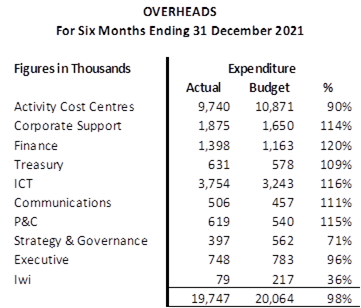
22. Overhead costs overall are
in-line with budget, however, within cost centres there is significant
variance.
22.1. Activity cost centres hold
the staff related costs for teams that work directly on Council
‘activities’. These are $1m behind budget with recruitment and
retention issues affecting many cost centres.
22.2. Finance is $230k over
budget reflecting the increased staffing levels to support the TechOne
implementation.
22.3. ICT operating expenditure
is $500k over budget through additional staffing costs. The operational
overspend offsets a capital underspend. The additional staff have been
brought on as employees, as opposed to contractors, because this is the
preferred way to secure the skillsets required to deliver the IT capital
programme. These costs have been on-charged to the ICT capital expenditure
projects reducing contractor expense. Staffing costs in both Finance and ICT
require further review within the full year accounts to ensure that they are
capitalised appropriately. This is complicated by technical decisions still to
be resolved around what Software as a Service (SaaS) costs can be amortised
over the life of systems rather than expensed directly. The operating
overspends are offset by underspends on capital projects.
22.4. People and Capability
(P&C) is above budget due to additional consultancy costs to support the
Covid-19 vaccination policy, high take up of workplace support services, and
increased health and safety training.
22.5. Strategy and Governance is
below budget following delays recruiting the climate change ambassador and
reduced costs for the Annual Plan due to the no consultation approach.
22.6. Maori Partnerships (Iwi) is
below budget due to vacant positions in the first half of the financial year.
Capital
Income and Expenditure
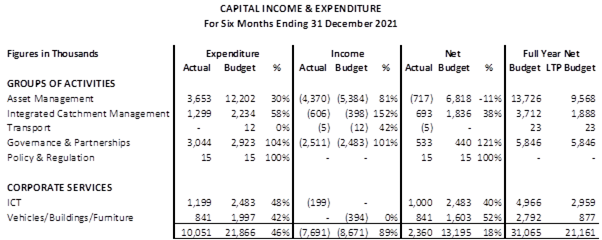
23. Capital expenditure is
$11.8m below budget.
24. Asset Management
expenditure is $8.5m behind budget.
24.1. Flood protection and
control works is $5.8m behind budget.
24.1.1. Infrastructure Reference
Group (IRG) expenditure is delayed. Significant commitments relating to the
Taradale stopbank reconstruction will be payable in the second half of the
financial year and the LTP split years 2 and 3 of the Level of Service and Gravel
Extraction projects equally, but year 3 expenditure will be materially higher.
24.1.2. Budgeted expenditure of
$150k on the Karamu Enhancement Scheme and Mary Doyle walking track will start
in the second half of the year.
24.1.3. Consent for the Clive River
dredging has been notified and requires a hearing, leading to further delays in
commencing work and a shortfall in expenditure of $550k.
24.1.4. Other work costing $550k is
delayed including the Plantation pump station upgrade (not started due to
design delays with the subcontractor), replacement of the Karamu stream and
other smaller scheme drainage assets have not started and may not be required.
24.2. Open Spaces is below budget
by $400k with Hawea Park development, Waitangi Park stage 3 and Pekapeka
improvements all behind schedule. The Waipatiki Park playground was completed
under budget.
24.3. Regional Water Security is
behind budget by $2.5m.
24.3.1. CHB Water Security is $875k
behind budget. The project team is currently awaiting completion of the
Cultural Impact Assessment following a series of engagements with mana whenua
groups and kaumatua in October-December 2021. This process of engagement
was initiated in September 2020 but has been impacted by delays due to Covid-19
and general capacity.
24.3.2. Te Tua Water Security is
$350k behind budget, with no progress this year.
24.3.3. The overall project has not
begun to spend the $2.8m carried forward from the previous year ($1.4m to 31
December 2021).
24.4. Income is reduced reflecting
the shortfall in expenditure on the IRG projects as funding is received in line
with expenditure.
25. Integrated Catchment
Management expenditure is $900k below budget
25.1. The largest single
shortfall ($400k) is in the 3D Aquifer Mapping project. GNS staff resourcing
has been impacted significantly by Covid-19 as they typically recruit
internationally, but have also been losing more international staff returning
home.
25.2. The technical equipment
replacement project is behind schedule due to the supply chain issues ($227k).
No risk to critical functions yet, just a slower pace of replacements.
25.3. Right Tree Right Place is
behind budget by $250k. Commercial and legal advice is still being progressed
on farm planting plans before the pilot farm work begins, and planting will
likely now be spread across multiple years to reduce the plant survival risk.
26. ICT expenditure is $1.2m
down on budget.
26.1. Projects are $1m behind
budget with the delays driven by recruitment challenges, organisational
readiness and business disruption from Covid-19. Estimates for full year
expenditure are $2.2m resulting in a full year shortfall of $2m. Some of this
is offset by overspends on operating expenditure as discussed earlier.
27. Vehicles/Buildings/Furniture
expenditure is behind budget by $1.1m.
27.1. Expenditure on new and
replacement vehicles is $300k behind budget due to delays in the vehicle supply
chain.
27.2. The accommodation
refurbishments are experiencing delays due to the supply of contractors and
workers.
27.3. The Raffles Street building
refurbishment ($500k) is on hold following the structural report concluding
that the building was earthquake prone.
27.4. Work on upgrading the Radio
Telephone network and equipment has not started but the contract has just been
signed so work is expected this year.
Covid-19 Impact
28. Covid-19 has impacted the
Council in several ways: increasing unit costs, supply chain and recruitment
issues, volatility in inflation and investment returns and the direct impact on
our teams through uncertainty and changing working conditions. Although some
costs have increased, there have also been reductions in expenditure where
projects have been delayed, technical expertise has not been available or
appropriate engagement has not been able to take place. It is very difficult to
quantify specific impacts related to Covid-19, especially with the other global
factors now present.
29. As an organisation we have
invested in our people by ensuring that business-critical people have a basic
home office setup and making available a $400 working from home allowance to
all staff. P&C has incurred additional costs through workplace support,
Covid-19 vaccination policy, and health and safety.
30. We will continue to operate
in a high inflation environment with a challenging, competitive and constrained
labour market. Delivering a large scale capital works programme relies on a
technically skilled workforce so staff retention and recruitment is paramount
to deliver outcomes.
31. Some more specific Covid-19
related impacts across the Council include:
31.1. Emergency Management has
incurred delays to some projects due to their continued work on the Covid-19
response.
31.2. Transport has had to reduce
the number of road safety events run and Total Mobility claims are down.
31.3. Purchasing of vehicles and
science equipment has been delayed due to the world-wide supply chain issues
from the pandemic leading to long delivery times and non-availability.
31.4. The Kotahi project under
Policy and Regulation has incurred the most delays from Covid-19 where
contracts for only one region have been set up to support iwi engagement. This
has not progressed due to the reduced ability to progress engagement with mana
whenua groups.
31.5. The CHB Water Security
project has been impacted with Covid-19 delaying the engagements with mana
whenua groups and kaumatua as part of the cultural impact assessment.
31.6. The weir being built at
Whakaki as part of the Enviro Enhancements project has been impacted by cost of
materials and supply shortages.
31.7. The sub-contractor for the
3D aquifer mapping project has been impacted by staffing issues due to the
border closures and inability to recruit and retain international specialists.
Decision Making Process
32. Staff have assessed the
requirements of the Local Government Act 2002 in relation to this item and have
concluded that, as this report is for information only, the decision-making
provisions do not apply.
Recommendation
That
the Corporate
and Strategic Committee receives and notes the Financial Report for the
Period 1 July - 31 December 2021.
Authored by:
|
Tim Chaplin
Senior Group Accountant
|
Christopher Comber
Chief Financial Officer
|
Approved by:
|
Jessica Ellerm
Group Manager Corporate Services
|
|
Attachment/s
There are no attachments for this
report.
HAWKE’S
BAY REGIONAL COUNCIL
Corporate
and Strategic Committee
16 March
2022
Subject: Organisational Performance
Report for the Period 1 October - 31 December 2021
Reason for Report
1. This item provides the
Organisational Performance Report for the second quarter of the 2021-2022
financial year which is the period 1 October to 31 December 2021.
Content
of the Report
2. The attached report
contains three parts, and an Executive Summary with highlights and lowlights
for the quarter.
2.1. Corporate Service Metrics focus on how well we are
performing across a number of corporate-wide measures such as health and safety
incidents and response to customer feedback.
2.2. Level of Service Measures by group of activities
with adopted targets, traffic light status and commentary by exception
(measures flagged amber and red only).
2.3. Activity
Reporting by group of activities with non-financial traffic light status and commentary.
3. This is the thirteenth
Organisational Performance Report to be presented. As with the last quarter,
the status and commentary reporting has been rolled up from ‘cost
centre’ to activity level. Commentary by cost centre is still available to committee
members via the dashboard.
4. As with the previous
report, this quarter does not include financial information due to the
implementation of the new financial system. Financial information by activity
for the half year is included on the agenda in a separate report.
5. Staff complete their
reporting in a software tool called Opal3. For level of service measures and
activity reporting, staff select the status (red, amber, green) of
non-financial results and provide commentary on what they did in the quarter.
Carbon
footprint
6. Commentary on
carbon credits and HBRC’s carbon portfolio is included.
7. Since quarter one 2021-22,
electricity use at Guppy Road, Wairoa and Raffles Street offices has been included in the report in addition
to the main office at Dalton Street.
8. From this
quarter, fuel
use by all HBRC vehicles, including Works Group equipment/plant, is
included.
Activity
reporting
9. Level of service measures
from the Long Term Plan 2021-2031 are reported. There are 40 measures that are
green, 9 amber, 1 red and 8 not measured/recorded.
10. Activities from the Long
Term Plan 2021-2031 are also reported. There are 19 activities that are green
and 3 that are amber.
Dashboard
11. The dashboard is produced
using PowerBI to give a visual representation of the results over time. The
Organisational Performance Report document is produced from the dashboard.
12. The dashboard also provides
committee members with the ability to delve deeper into activities of interest
(via cost centres) and all level of service measures results (not just by
exception).
13. Annual community outcome
results (which are the same as the 24 strategic goals from the Strategic Plan
2020-2025) are reported on at the end of the financial year only.
14. To access the dashboard,
please open your PowerBI app on your iPad. The dashboard will be on your
homepage.
15. We are continuously
improving the dashboard and improving the data reliability across all areas,
and would appreciate any feedback you have.
Future developments
16. The Strategy and
Performance team will be working with the Risk and Corporate Compliance team to
incorporate risk monitoring and corrective actions by determining tolerance
levels (particularly across our Corporate Metrics). These will then be
incorporated into future reporting.
17. Financial reporting will be
re-introduced to the report as soon as we are able.
18. Further
improvements, particularly around the Corporate Metrics, will be incorporated
when data can be tested and reported with confidence to provide additional
information.
Decision Making Process
19. Staff have assessed the
requirements of the Local Government Act 2002 in relation to this item and have
concluded that, as this report is for information only, the decision-making
provisions do not apply.
Recommendation
That
the Corporate
and Strategic Committee receives and notes the Organisational Performance
Report for the Period 1 October - 31 December 2021.
Authored by:
|
Kelly Burkett
Business Analyst
|
Sarah Bell
Team Leader Strategy &
Performance
|
Approved by:
|
Desiree Cull
Strategy & Governance Manager
|
|
Attachment/s
|
1⇩
|
Q2 October - December 2021
Organisation Performance Report
|
|
|
|
Q2 October - December 2021
Organisation Performance Report
|
Attachment
1
|
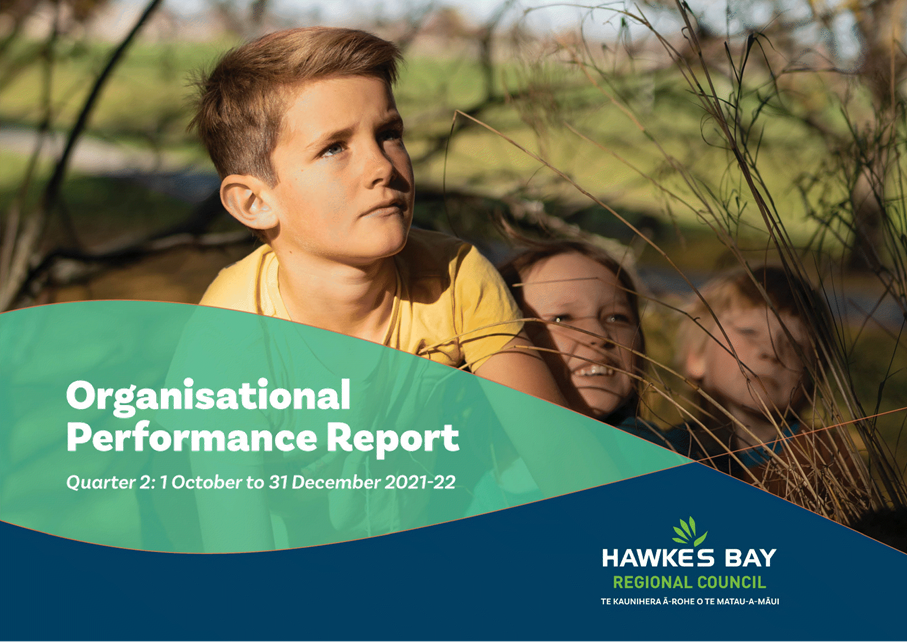




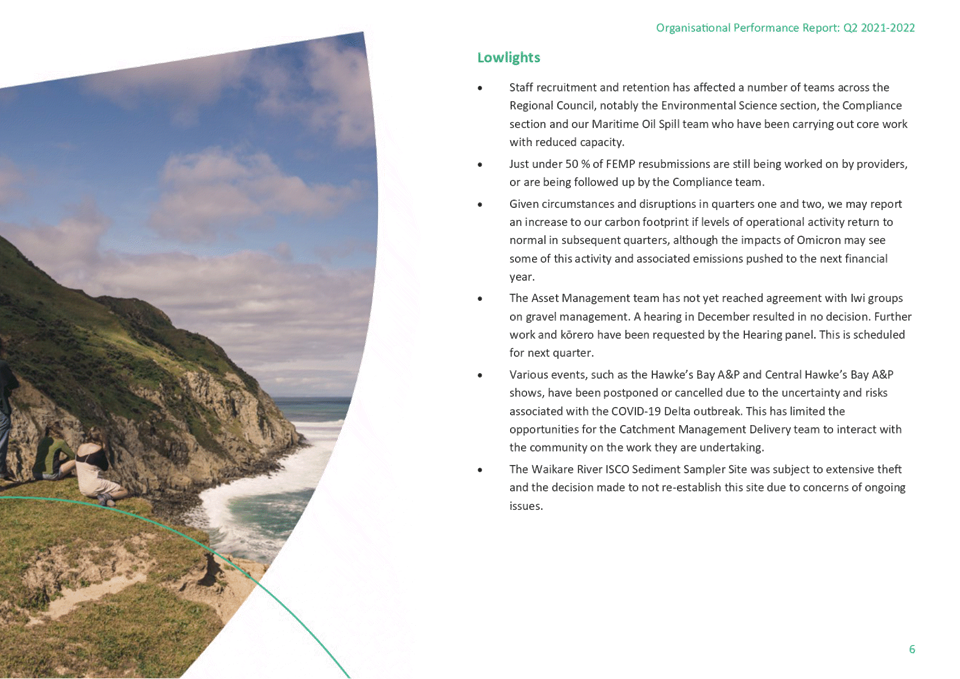
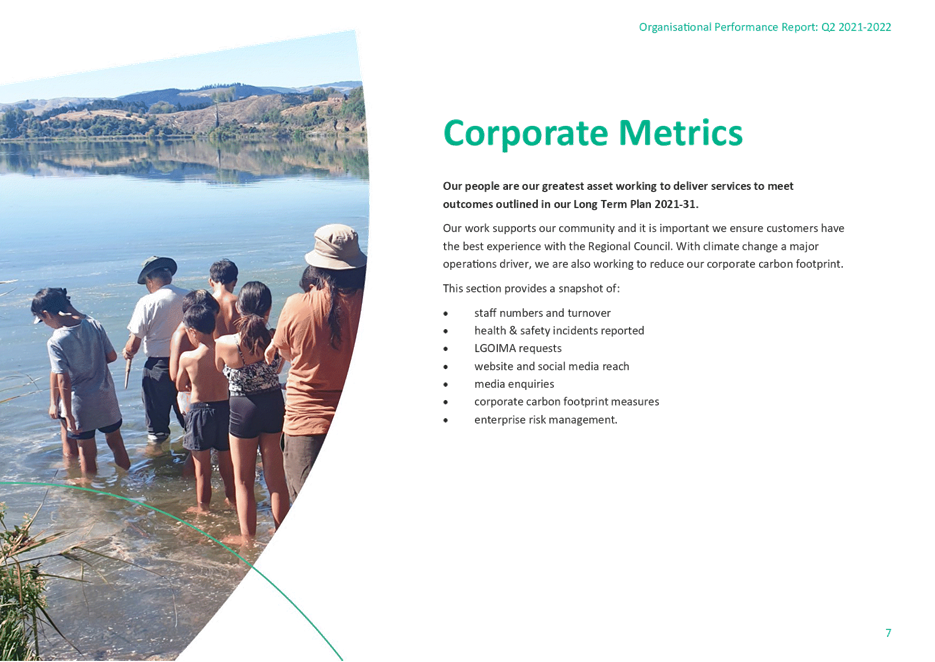
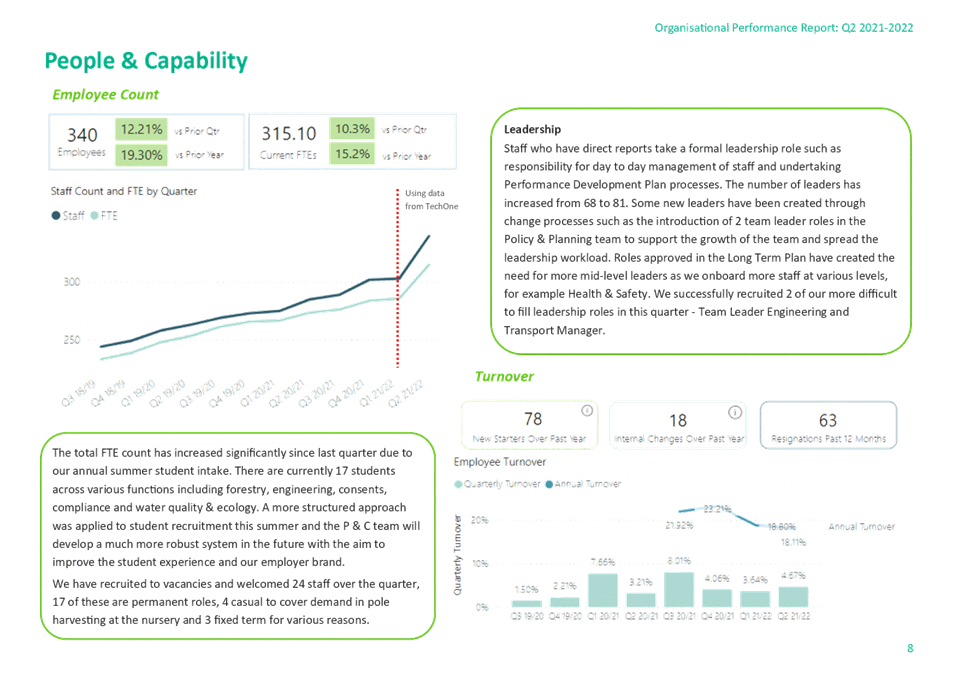
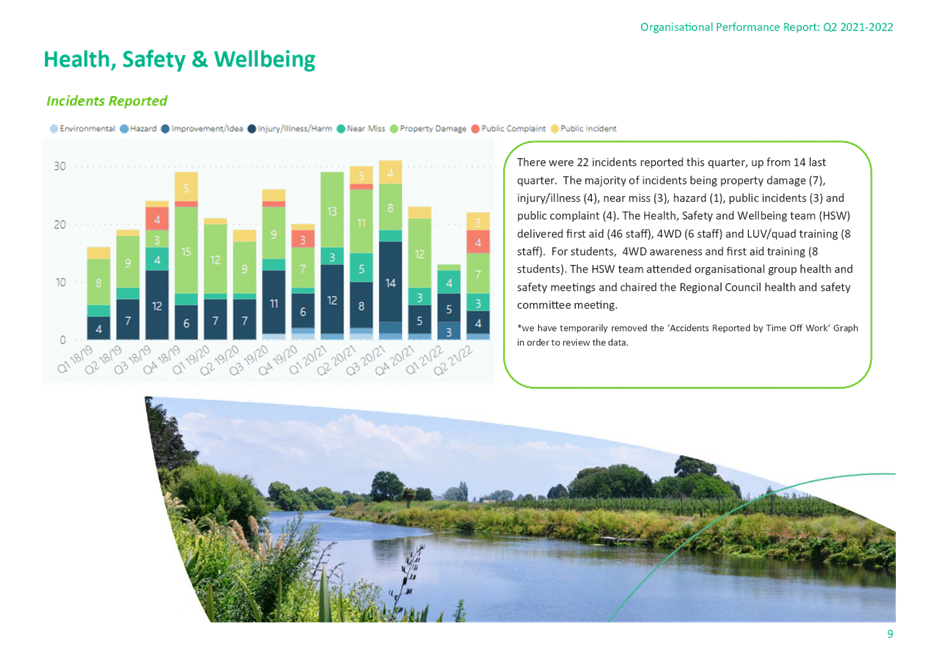
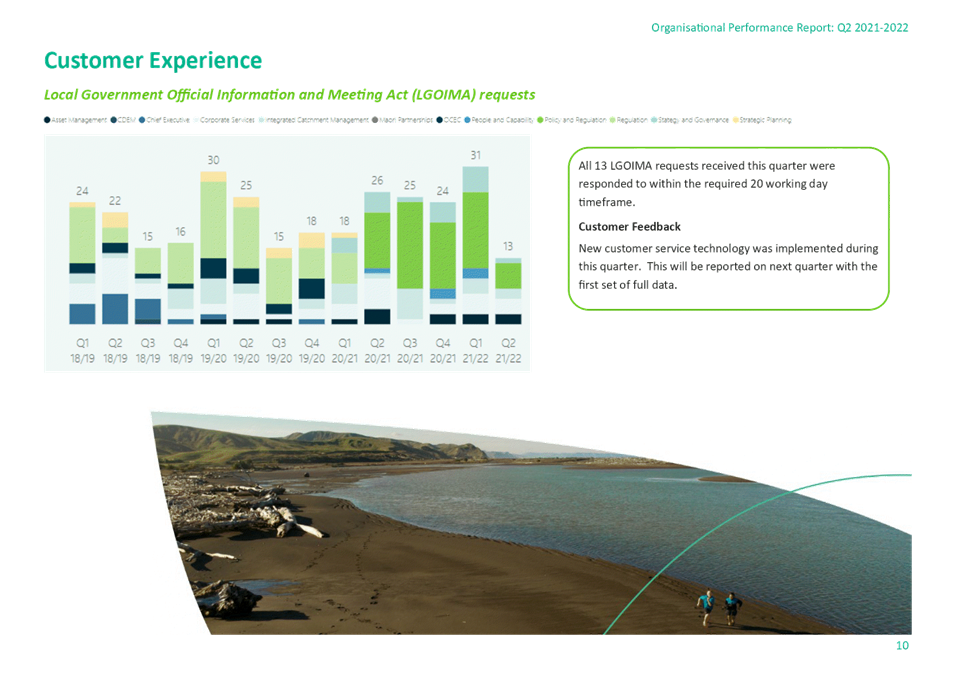
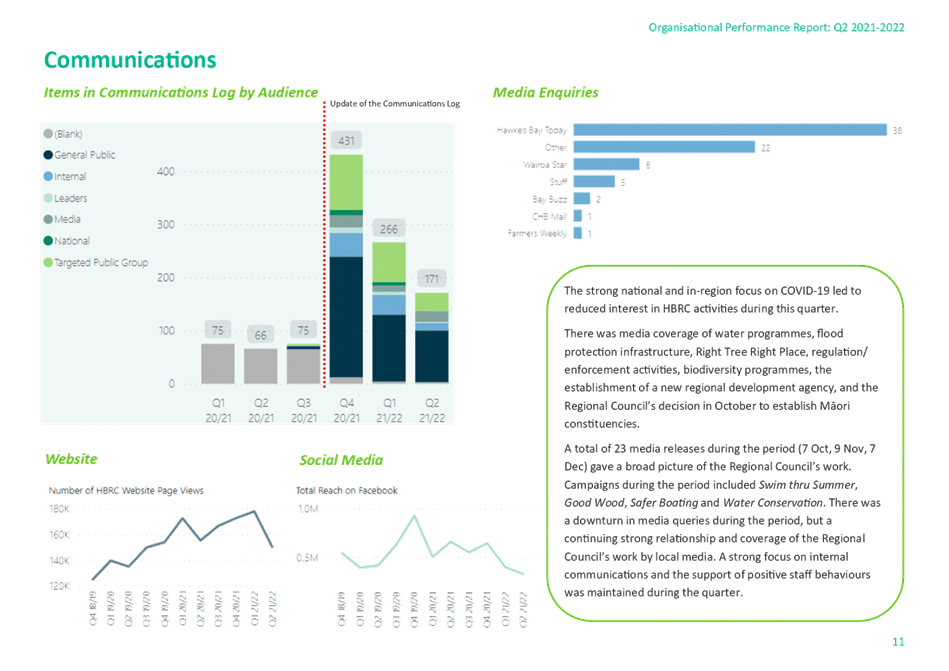

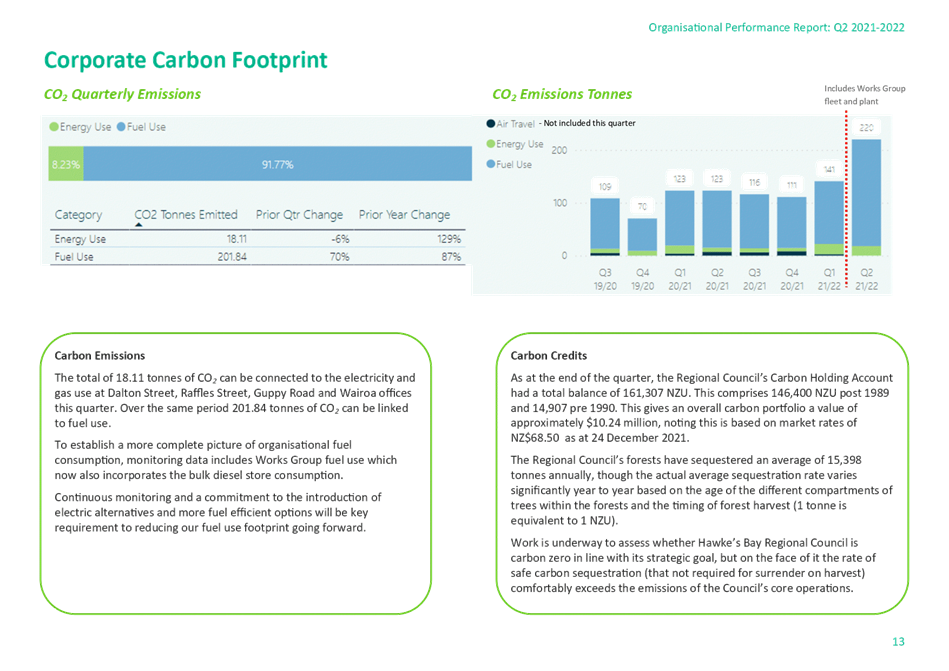

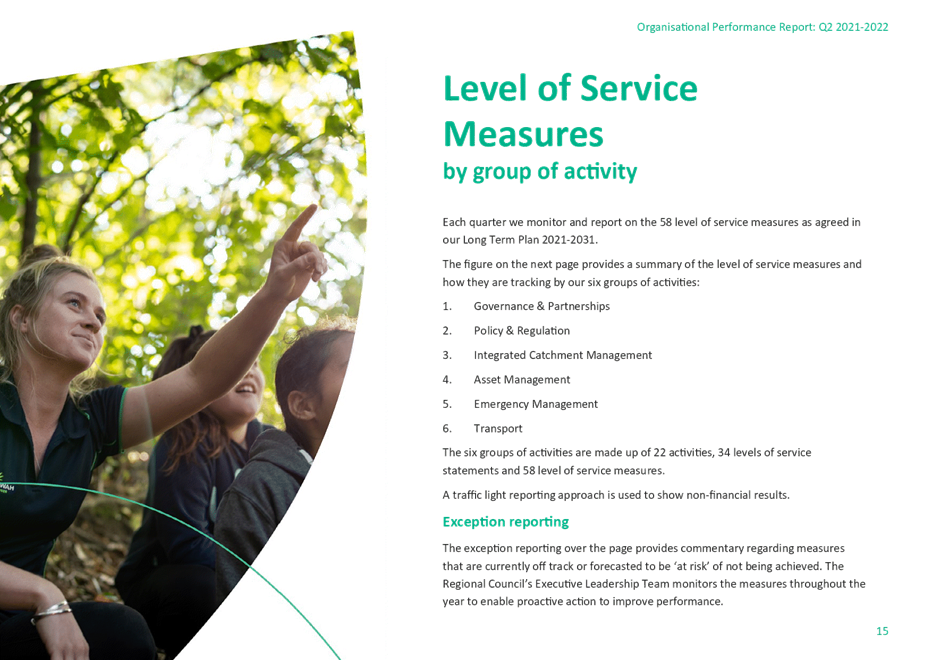
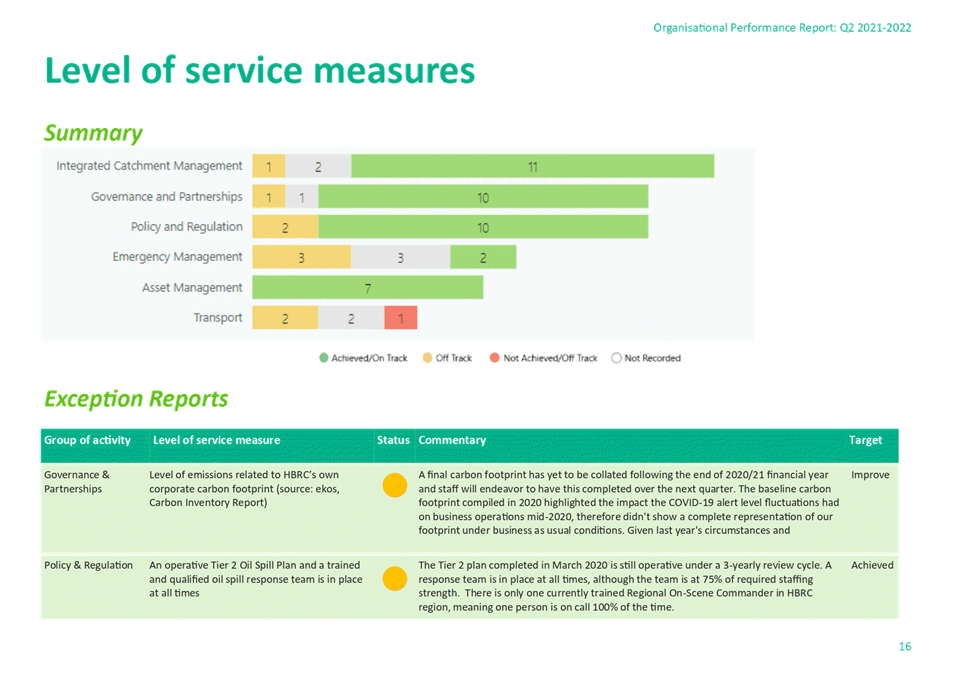

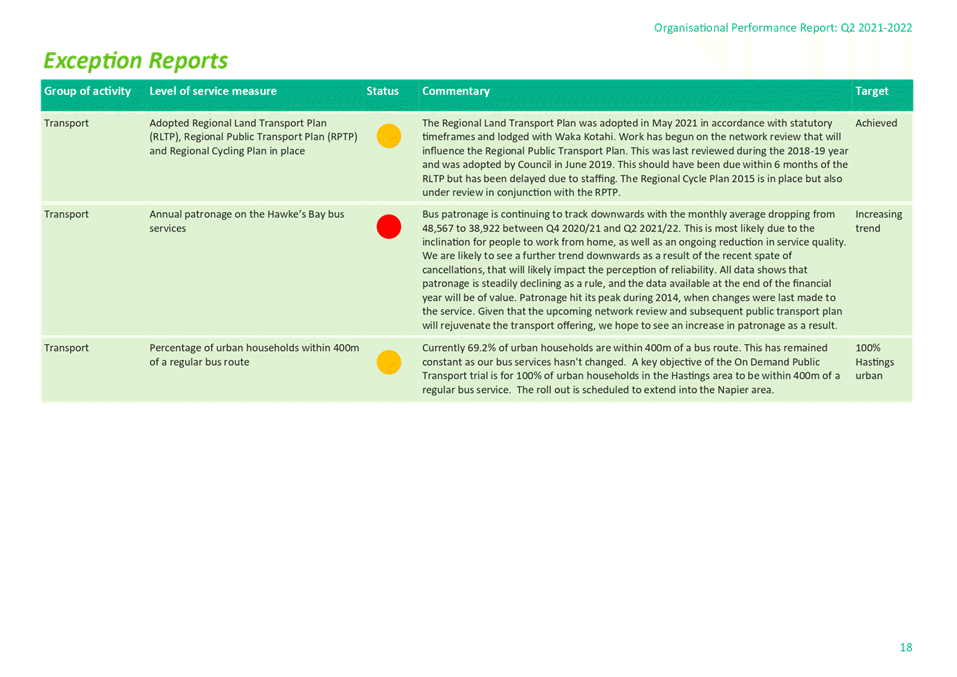
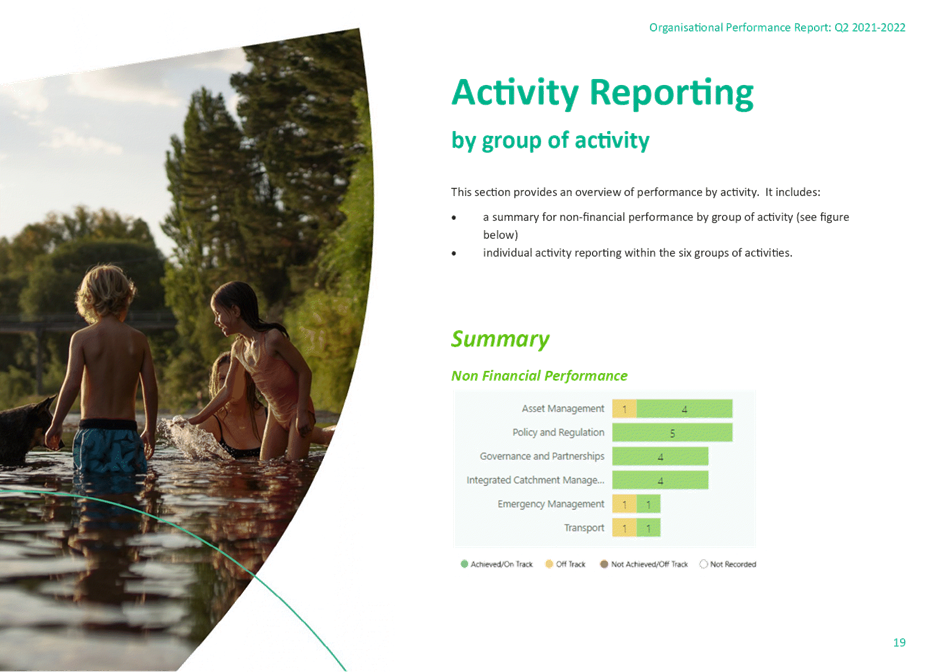
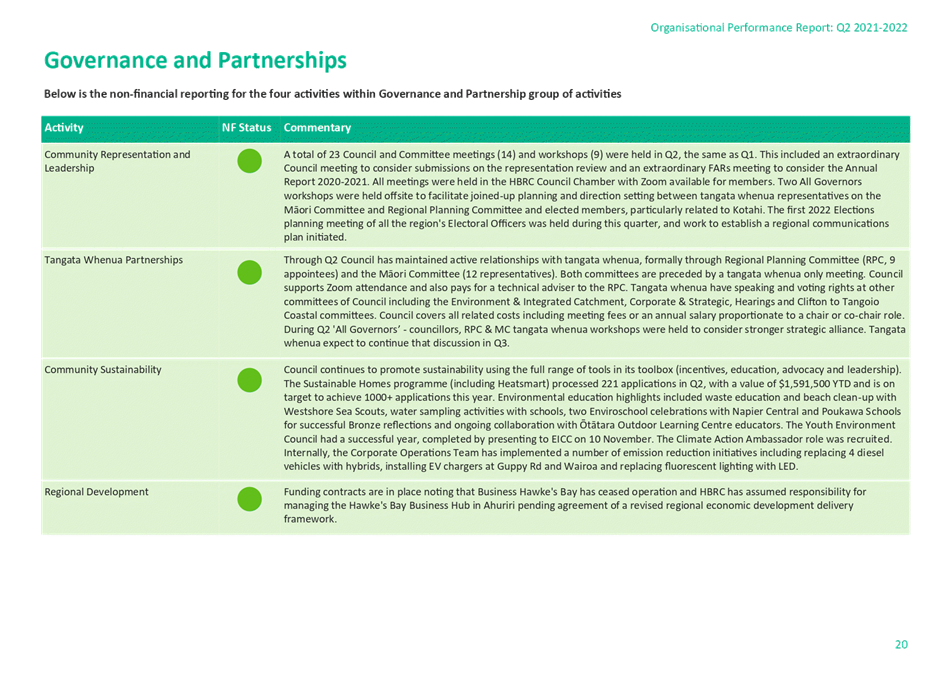


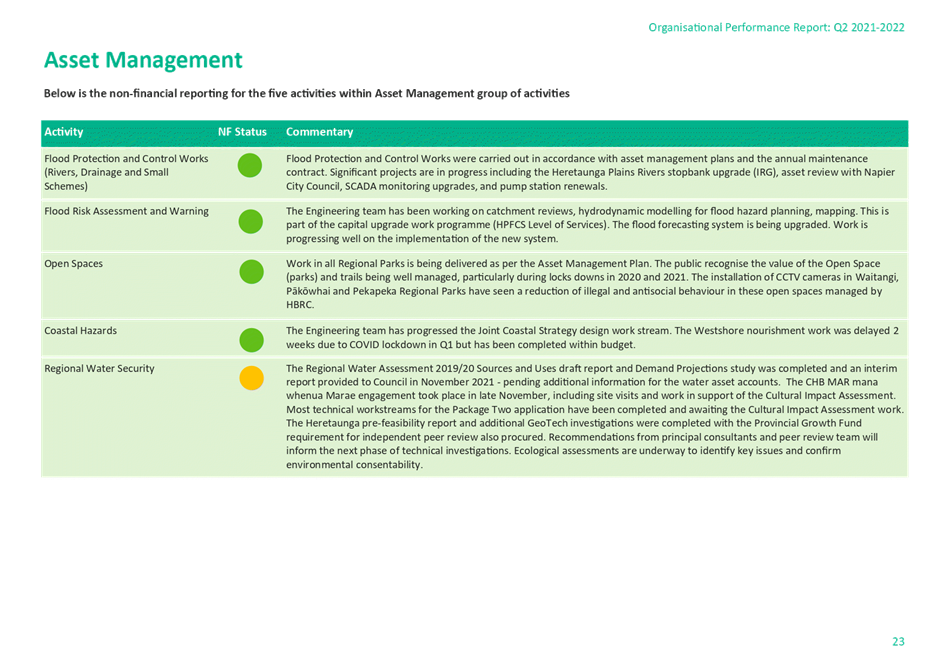
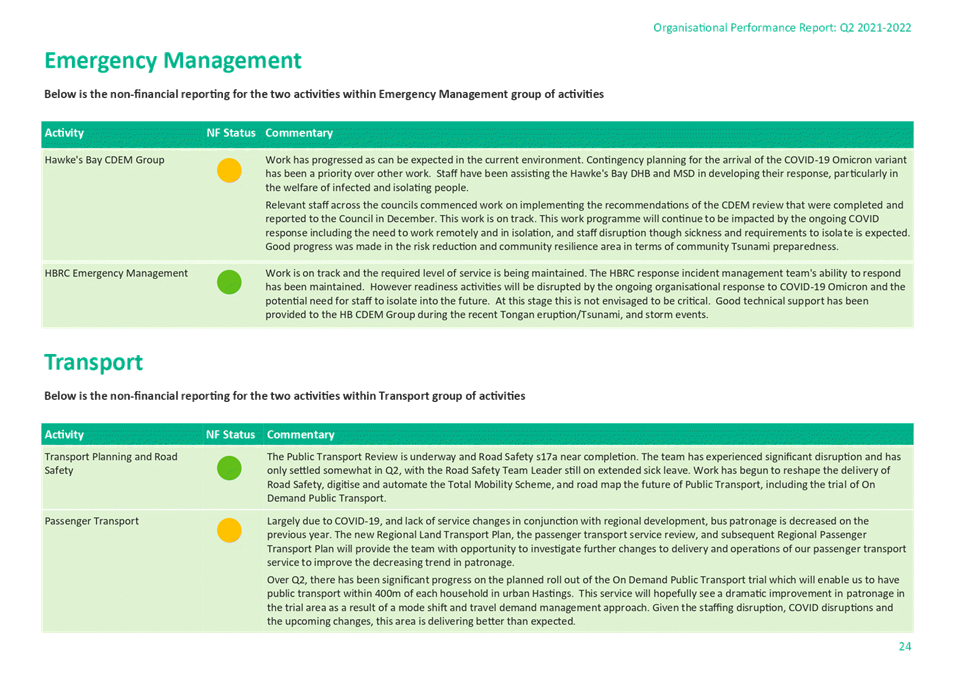
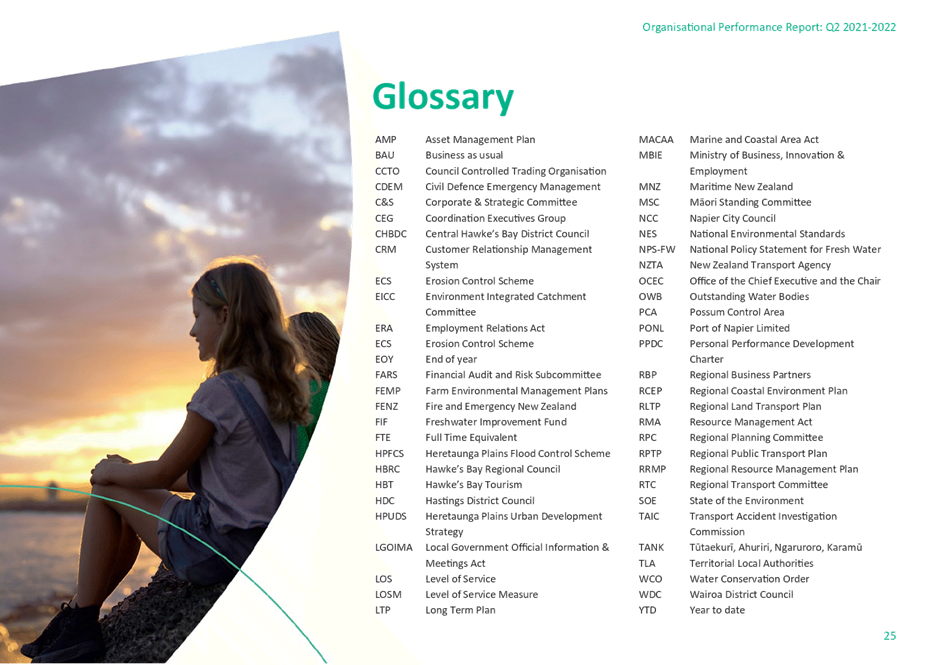
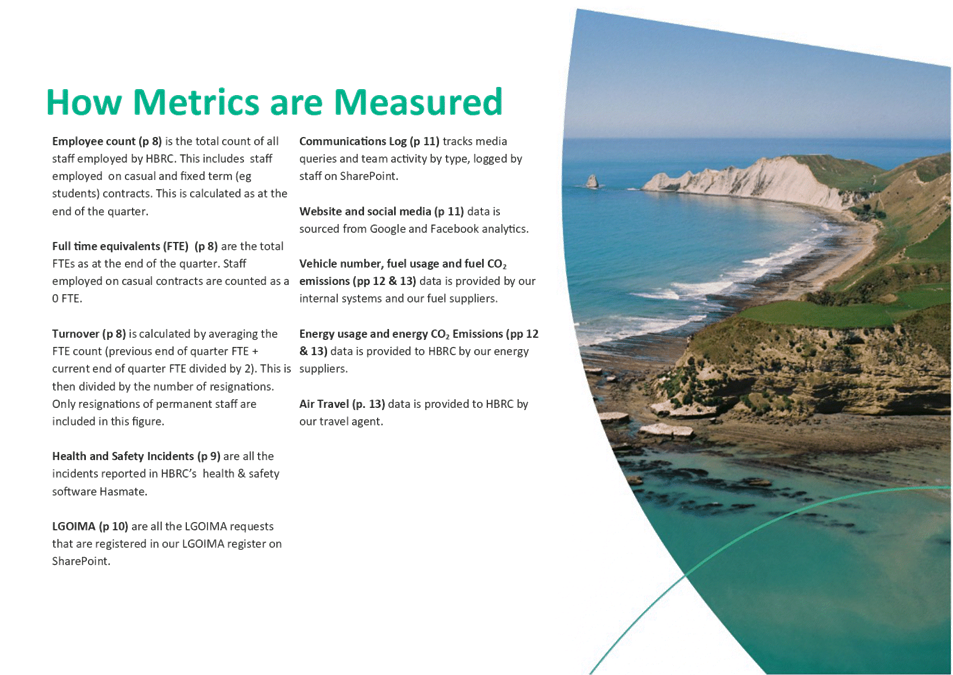
HAWKE’S BAY REGIONAL
COUNCIL
Corporate
and Strategic Committee
16 March
2022
Subject: Corporate Plan Implementation
Reason for Report
1. This item provides the
Committee with an update on progress implementing the 2021-2024 Corporate Plan,
with specific focus on the IT capital work programme delivery. Also included
are an overview of the Finance System Implementation Project, which has now completed,
and context for next steps of the TechnologyOne system integration.
Background
2. The 2021-2024 LTP was
supported by the creation of the first Corporate Plan, recognising a need to
better manage and assist the coordination of the many competing priorities and
change initiatives of the corporate, people management and governance functions
of Council.
3. Consolidating rapid growth
over the past five years, and some urgency to move toward a more mature
operating model to reduce risk in corporate frameworks, while balancing the
pace and cost of change for our people and our community, continues to be an
ongoing challenge.
4. The Corporate Plan comprises:
4.1. Corporate Support
4.2. Finance and Procurement
4.3. Governance and Strategy
4.4. Information and
Communication Technology (ICT)
4.5. Marketing and
Communications
4.6. People and Capability
4.7. Risk and Assurance.
Update
5. Despite the first 9 months
of the current LTP period being a disruptive and challenging time to deliver
change, and significant focus and resource being directed toward the Finance
System Implementation project, many of the Y1 initiatives are well under way,
as highlighted in Attachment 1 Initiatives that help deliver our strategy.
6. As we progress, we are
having to work against many factors, specifically external, such as a
restricted labour market, continual business disruptions, and supply chain
uncertainties. The plan has evolved in response to those challenges and we are
learning as we go and we are still making good progress.
7. Staff will be present at
the 16 March meeting to discuss the highlighted initiatives and some of the
challenges and success in more detail with the Committee. A separate public
excluded item on the 16 March agenda discusses the People and Capability
Strategy and specifically the plan to address challenges in mentioned within
this report relating to retention and recruitment.
8. Some key areas of progress
are highlighted as follows.
Customer
Experience
9. Great progress has been
made in customer experience (CX) with the creation of a Contact Centre. Supporting a
customer focus and a significant shift in business maturity in this space is
providing a more structured approach to how we interact with the community.
10. New systems, Zendesk and
PureCloud, are high quality tools that are working well, and the CX team is
growing their confidence in their new way of working every day. An ability to
measure and monitor data provides valuable information to the organisation
about the type of enquiries we receive and will proactively drive improvements
in customer satisfaction levels.
11. The team is now
the first point of contact and resolution of all general enquiries, rates
enquiries, transport enquiries and sustainable homes enquiries. This new
model has taken some time to embed, but has largely been a very smooth
transition - a well-delivered project which combines technical solutions with
strong people, process and change aspects combined.
12. This project has created a
strong foundation for the CX team and the rest of HBRC to build on. It was
delivered $150k under budget (from a total $400k budget) and has provided the tools to deliver on its
objectives to:
12.1. improve the quality and
consistency of service for customers
12.2. improve HBRC CX team
operational efficiency
12.3. reduce impact of customer
contact on non-CX HBRC staff
12.4. build business continuity
for our customer service function to be managed remotely when required, e.g.
COVID disruptions or emergency events
12.5. aim for customer excellence
by bringing visibility to the quality of service offered to the community
12.6. use data to drive
improvements.
ICT
13. Significant capital
investment was committed to deliver a revised and comprehensive technology
approach that strives to get the right information to the right people at the
right time – a key aspect of the Corporate Plan.
14. Year 1 aimed to
deliver an implementation plan for the $30m IT capital work programme. The plan
includes:
14.1. project portfolios
14.2. technology
architecture
14.3. project
delivery and resourcing plans, and
14.4. further
detailed project scoping.
Update
15. Project portfolios,
technology architecture and project delivery plans are all ahead of schedule.
Resource plans are also on track. Scoping is the most challenging area, due to
the shortage of business analysis capacity, however we are mitigating this via
active recruitment and by building internal capabilities.
16. The headwinds and future
risks that we are planning for include a highly competitive talent market, data
quality issues, organisational change readiness and technical complexity (from
‘dis’-integrated architecture and ‘dis’-aggregated
infrastructure).
17. Chief Information Officer
(CIO), Andrew Siddles, will be in attendance on 16 March to discuss how the IT
capital work programme and the project prioritisation timeline (Attachment 2)
continue to shift and flex in response to the changing landscape we operate
within.
18. A key strategic project
within the IT capital work programme that has been completed within the current
financial year is the delivery of TechologyOne, the new integrated Financial
Management Information System - the project referred to internally as FUSE.
This was a transformational project that touched the entire organisation and
was challenging due to:
18.1. a tight timeframe
18.2. challenges recruiting
technical resources
18.3. unprecedented turnover
18.4. a global pandemic
18.5. delivering a big change
project of this kind for the first time at HBRC.
19. An overview of the project
is provided as follows.
FUSE
- What did we do?
20. The project was started in
2018 with a series of workshops to understand requirements and a subsequent
solution evaluation through Government Electronic Tender Service.
21. The TechnologyOne solution
was identified as the preferred system due to the fact it was a full Enterprise
Resource Planning System (ERP) designed for councils which had the ability to
meet current financial system requirements, as well as being able to expand
into future areas such as a Human Resource Information System (HRIS) and Asset
Management system. The Tenders Committee accepted the proposal to proceed
with TechnologyOne OneCouncil solution on 27 May 2020.
22. The implementation project
commenced in July 2020 with a view to having all initial modules and
functionality implemented by 1 July 2021 to align with the Long Term Plan
financial year timeframes.
23. Enterprise Budgeting was
implemented first in October 2020 to enable development of the LTP budgets
within the new software, which would prepare the solution for implementation of
other financial processes at the start of the 2021-2022 financial year.
Why
did we do it?
24. The previous finance
systems were overdue for replacement, were unsupported, and presented Council
with significant risks that could have led to data corruption, security
compromise, system instability or unavailability.
25. Many of the financial
processes were also highly dependent on manual data entry, with significant
effort within the Finance team spent checking and double-checking data in paper
reports to ensure errors were not made. Data had to be retrieved from a network
of different solutions and manually compiled to generate the budget and reporting
outputs that underpinned critical decision making.
What
were the challenges?
26. The project consistently
operated with a shortage of suitably skilled resources in both IT and Finance.
This amplified the difficulty of delivering a highly ambitious project scope in
a compressed timeframe.
27. Now that the solution is
implemented, the bulk of the challenges are not with the solution itself, but
with the process changes it has introduced and employee capacity, ability and
desire to adapt to them. Change of this type is always hard, and this is a
transformational project impacting almost every Council employee at one level
or another.
28. Our Finance team is
impacted the most, as they are tasked with understanding new ways of working in
almost all aspects of their role while concurrently coping with loss of
capacity and knowledge caused by staff turnover and multiple vacancies.
Vacancies included the Chief Financial Officer (CFO) role, which created gaps
in understanding the rationale of configuration decisions and delayed decision
leadership to drive and embed process change.
What
did we do to address the challenges?
29. As each of the challenges
arose, we adapted to address them. We focused on building more capacity
in the key roles of CFO and CIO while we embedded the significant process and
technology changes being introduced.
30. The Group Manager Corporate
Services stepped into the CFO role to provide leadership and direction for the
Finance team while we negotiated the project transition phase. This also
enabled the previous acting CFO to increase Finance team capacity to address
and understand processes and any issues that arose.
31. Technical support
arrangements with our suppliers are also being refined to help us through the
peak transition workload.
Budget
32. A budget of $2M was allowed
over the 2030-2021 and 2021-2022 financial years. This budget was exceeded by
$400K (<20% overspent), with the overspend being largely attributable to
understated internal labour costs and underestimated project resource
requirements. This has served to enable improved budgeting for future
projects with a clearer understanding of actual costs.
33. One key learning from this
project is that greater contingency is required, given the uncertainties with
current labour markets when planning for these types of projects. We had
to be creative and recruit additional resources in order to mix and match the
skillset requirements.
Our
Current Status
34. We are exactly where we
would expect to be at this stage of a major system implementation. We have
implemented a solution that is working as it was designed, and are now focused
on embedding the significant business process changes that it has introduced.
35. The rapid pace of our
implementation has left us with some technical work that still needs to be
done, but we have managed to retain critical technical staff to address this.
Their focus is currently on assisting their colleagues with understanding
processes and resolving any issues that occur. Soon we will shift our focus to
optimising the deployment and improving the processes implemented.
36. We now have a modern
integrated financial solution that replaces numerous legacy systems, and that
provides a solid platform for future enhancement and extended functionality.
37. The project delivered
functionality to the required deadline of 1 July 2021 which enables users to
create budgets, record timesheets, manage leave, create and approve purchase
orders, as well as manage accounts payable and accounts receivable processes.
38. The FUSE project is the
first step in the deployment of a full ERP solution for HBRC. Subsequent
stages and projects are now being planned. These include a project to
review and extend already deployed functionality including Contract Management
and Reporting, as well as projects to implement Property & Rating, Human
Resources and Asset Management as originally intended. A presentation of the
integration roadmap will be made at the 16 March meeting.
Revenue and Financing Policy Review
39. This project
was planned to start in Year 1 of the Corporate Plan but, due to the
redeployment of the resource earmarked to work on this project as acting CFO
and the implementation of the new finance system, it is only now gaining
momentum.
40. The first principles review of
our Revenue and Financing Policy will be undertaken over the next 18 months via
a series of council workshops to decide the funding mix of each rate. The aim
of the review is to improve transparency and fairness for who pays what, ensure
legal compliance and simplify the policy thereby providing more flexibility in
application without the need to consult. Consultation is planned to take place
towards the end of 2023 prior to the next Long Term Plan when the amount rated
may change. Separating the two processes is important as it enables us to
distinguish between the impact on a ratepayer from the policy change versus a
level of service or cost change.
41. It is proposed that one of
the first rates to be reviewed is the Upper Tukituki Flood Control
Scheme. This was promised to scheme ratepayers as part of the
consultation topic in the 2021-2031 Long Term Plan to leverage central government
funding to accelerate the removal of gravel from the scheme. The review will
look at the differential categories for the Tukituki flood protection scheme
with the goal to spread the costs more appropriately across urban and rural
beneficiaries.
Decision Making Process
42. Staff have assessed the
requirements of the Local Government Act 2002 in relation to this item and have
concluded that, as this report is for information only, the decision making
provisions do not apply.
Recommendation
That
the Corporate
and Strategic Committee receives and notes the Corporate Plan Implementation
staff report.
Authored by:
|
Desiree Cull
Strategy & Governance Manager
|
Tim Price-Walker
Organisational Change Manager
|
|
Stacey Rakiraki
Corporate Operations Manager
|
Andrew Siddles
Chief Information Officer
|
Approved by:
|
Jessica Ellerm
Group Manager Corporate Services
|
|
Attachment/s
|
1⇩
|
Initiatives that help deliver our
strategy
|
|
|
|
2⇩
|
HBRC Pathway to a Full ERP
|
|
|
|
Initiatives that help deliver our
strategy
|
Attachment
1
|
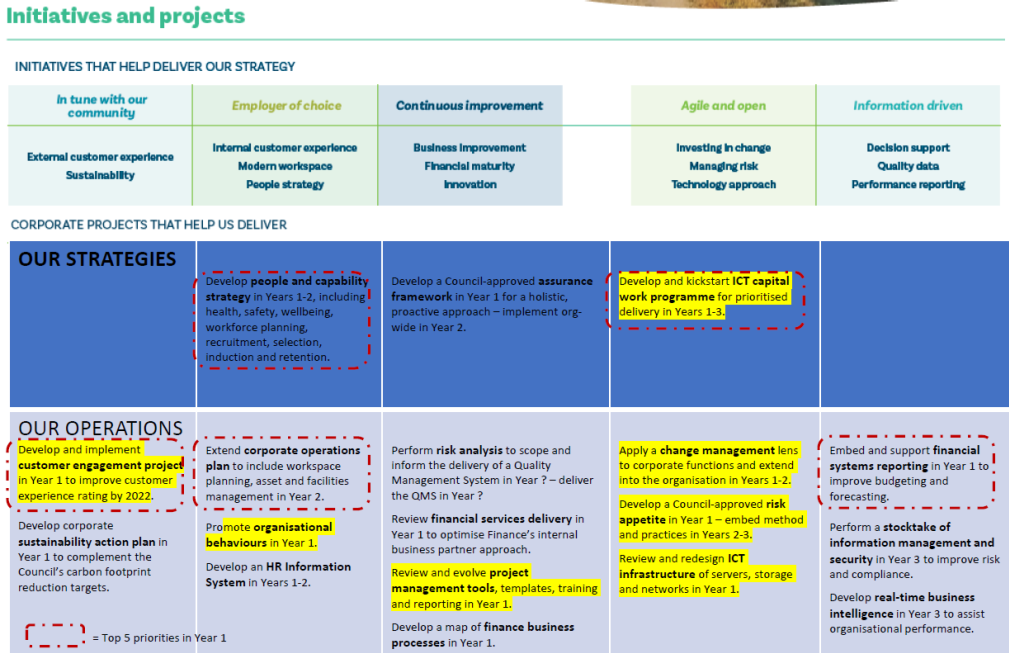
|
HBRC Pathway to a Full ERP
|
Attachment
2
|
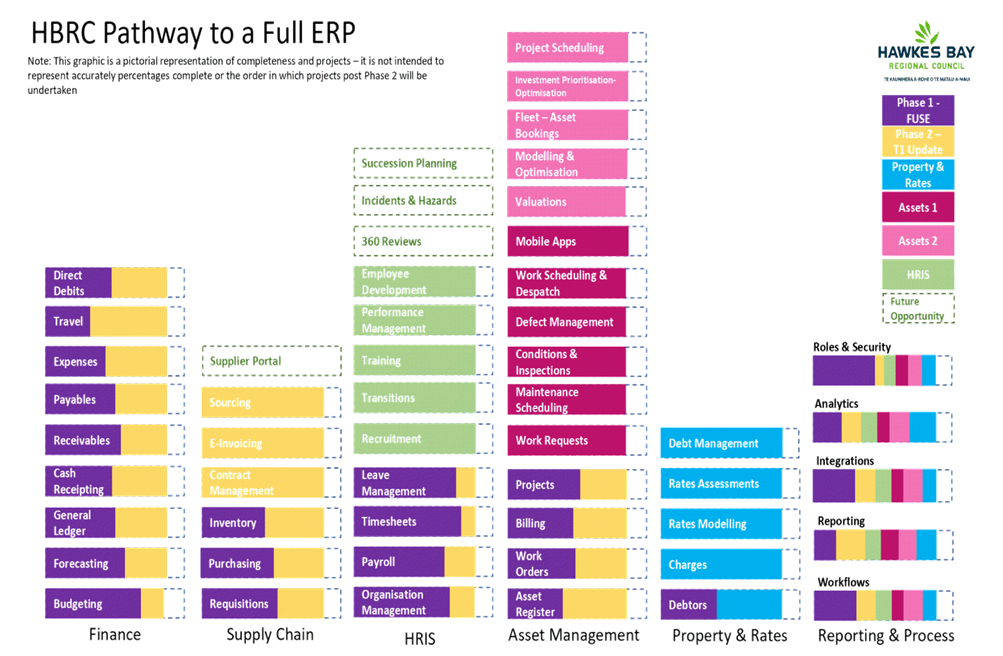
HAWKE’S
BAY REGIONAL COUNCIL
Corporate
and Strategic Committee
16 March
2022
Subject: Discussion of Minor Items not
on the Agenda
Reason for Report
1. This document
has been prepared to assist committee members to note the Minor Items Not on
the Agenda to be discussed as determined earlier in Agenda Item 5.
HAWKE’S BAY REGIONAL
COUNCIL
Corporate
and Strategic Committee
16 March
2022
Subject: Report from the Public
Excluded Finance, Audit and Risk Sub-committee Meeting
That
the Corporate and Strategic Committee excludes the public from this section of
the meeting, being Agenda Item 17 Report from the Public Excluded Finance,
Audit and Risk Sub-committee Meeting with the general subject of the item to be
considered while the public is excluded; the reasons for passing the resolution
and the specific grounds under Section 48 (1) of the Local Government Official
Information and Meetings Act 1987 for the passing of this resolution being:
|
GENERAL
SUBJECT OF THE ITEM TO BE CONSIDERED
|
REASON
FOR PASSING THIS RESOLUTION
|
GROUNDS
UNDER SECTION 48(1) FOR THE PASSING OF THE RESOLUTION
|
|
Report from the Public
Excluded Finance, Audit and Risk Sub-committee Meeting
|
s7(2)(f)(ii) The
withholding of the information is necessary to maintain the effective conduct
of public affairs through the protection of such members, officers,
employees, and persons from improper pressure or harassment.
s7(2)(j) That the public
conduct of this agenda item would be likely to result in the disclosure of
information where the withholding of the information is necessary to prevent
the disclosure or use of official information for improper gain or improper
advantage.
|
The Council is specified,
in the First Schedule to this Act, as a body to which the Act applies.
|
Authored by:
|
Tim Chaplin
Senior Group Accountant
|
Christopher Comber
Chief Financial Officer
|
|
Ross Franklin
Finance Consultant
|
Olivia Giraud-Burrell
Quality & Assurance Advisor
|
|
Helen Marsden
Risk & Corporate Compliance
Manager
|
Liana Monteith
Manager People and Capability
|
|
Andrew Siddles
Chief Information Officer
|
|
Approved by:
|
Jessica Ellerm
Group Manager Corporate Services
|
|
HAWKE’S BAY REGIONAL
COUNCIL
Corporate
and Strategic Committee
16 March
2022
Subject: Possible Sale of Wellington
Leasehold Property
That
the Corporate and Strategic Committee excludes the public from this section of
the meeting, being Agenda Item 18 Possible Sale of Wellington Leasehold
Property with the general subject of the item to be considered while the public
is excluded; the reasons for passing the resolution and the specific grounds
under Section 48 (1) of the Local Government Official Information and Meetings
Act 1987 for the passing of this resolution being:
|
GENERAL SUBJECT OF THE ITEM TO BE CONSIDERED
|
REASON
FOR PASSING THIS RESOLUTION
|
GROUNDS
UNDER SECTION 48(1) FOR THE PASSING OF THE RESOLUTION
|
|
Possible Sale of
Wellington Leasehold Property
|
s7(2)(i) That the public
conduct of this agenda item would be likely to result in the disclosure of
information where the withholding of the information is necessary to enable
the local authority holding the information to carry out, without prejudice
or disadvantage, negotiations (including commercial and industrial
negotiations).
s7(2)(j) That the public
conduct of this agenda item would be likely to result in the disclosure of
information where the withholding of the information is necessary to prevent
the disclosure or use of official information for improper gain or improper
advantage.
|
The Council is specified,
in the First Schedule to this Act, as a body to which the Act applies.
|
Authored by:

























































































































